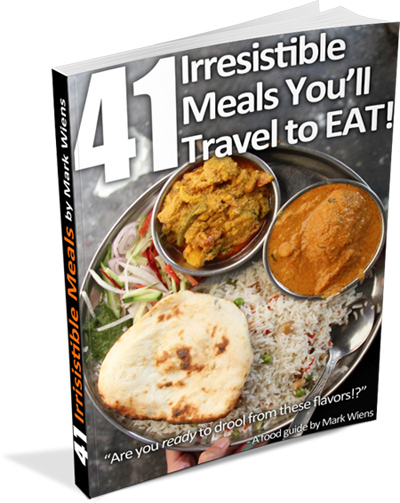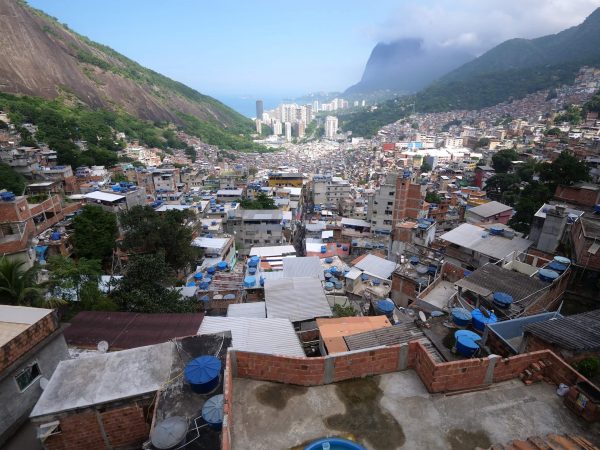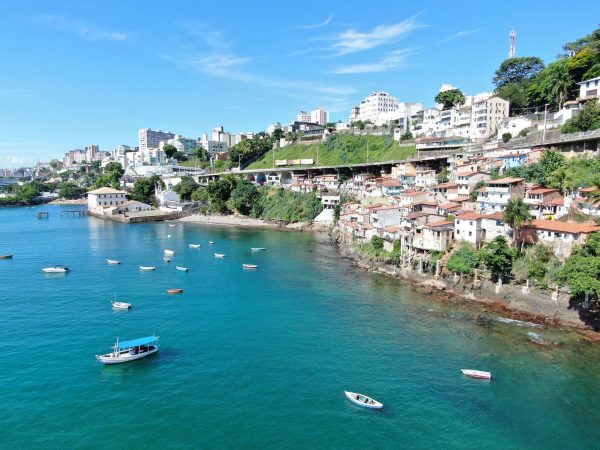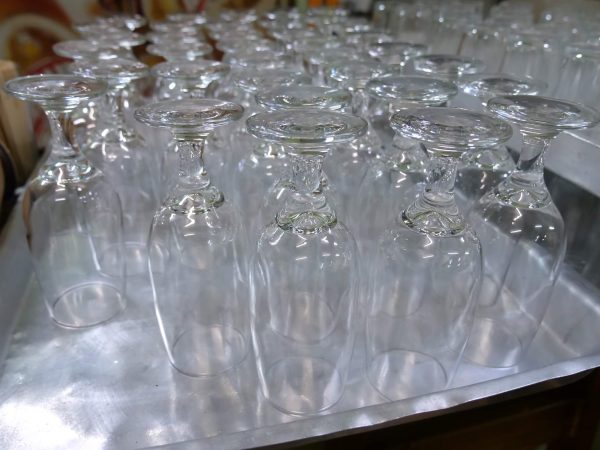
Salvador is a city in the Brazilian state of Bahia, and a place in Brazil that you absolutely need to visit.
On Brazil’s Atlantic coast, Salvador is home to a unique Afro-Brazilian culture that literally exists here, and nowhere else in the world.
In this article, I want to give you some ideas about a few of the things you could do here, and share (a lot) of the wonderful things that you need to eat in Salvador.
Full Salvador video guide
(Watch the full street food tour of Salvador in the video above, or watch it on YouTube here)
You Should Visit Bahia
In this article, I will share all the details you need to create a massive and delicious One-Day Itinerary in Salvador.
You will find restaurant information, map locations, details, and photos, everything you’ll need to explore Salvador.
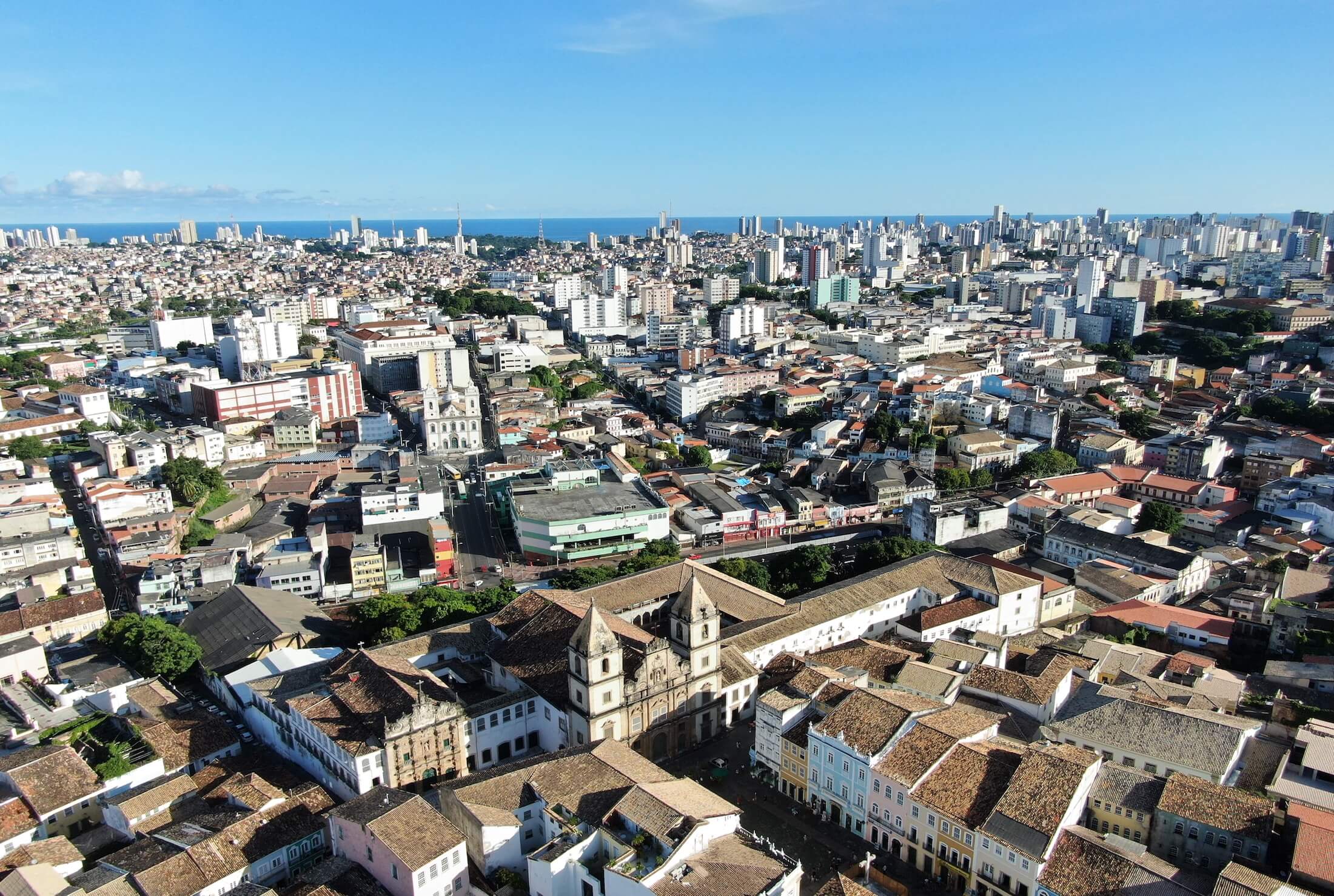
An Overview of This Article
There’s so much to do in Salvador, this might even be a two-day exploration for some.
Therefore, you might also try learning about Salvador in the order I’ve listed below (the two groups of places include things that are physically near to each other).
Part 1
Start your day with a visit the Sao Joaquim Market (many local fruits and snacks to eat there) and then stop at a beautiful, quiet beach to visit a gorgeous example of the city’s history (some say the Solar do Unhão is the most beautiful spot in all of Salvador).
Be sure to check out the 5 Best Foods of Salvador (final section of this article) and order a few of them for breakfast today, and a few others for your lunch.
Continue just 1 km north along the bay to visit the Mercado Modelo, a good place for buying souvenirs, and some delicious local food. Next, take the famous Lacerda elevator to the Upper City, walk towards Pelourinho (classic architecture and cobbled streets), and practice Capoeira with some professional performers on the way (North-East Brazil’s unique martial art).
Part 2
Circle around the historic morning streets of Salvador town to enjoy the morning air (visit Pelourinho), and have a coffee while you enjoy some truly lovely views of Portuguese-style architecture, looking out over the bay’s beautiful blue water.
Take a short walk from the Lacerda elevator over to see a street-performance of Olodum (the amazing local drum culture), all the while stopping off for snacks along the way.
Finally, learn which restaurants to visit, and what to order when you’re there, using our list of the 5 Best Foods in Salvador.
We absolutely loved our time with the people of Salvador, this town has a great atmosphere, absolutely incredible local food, and I’m sure you’ll love it too.
Note: While we did this self-guided tour of Salvador in one amazing and ultimate day, it would be just as enjoyable to break this into two days (which would actually give you more time to eat at all those restaurants you want to visit as well).
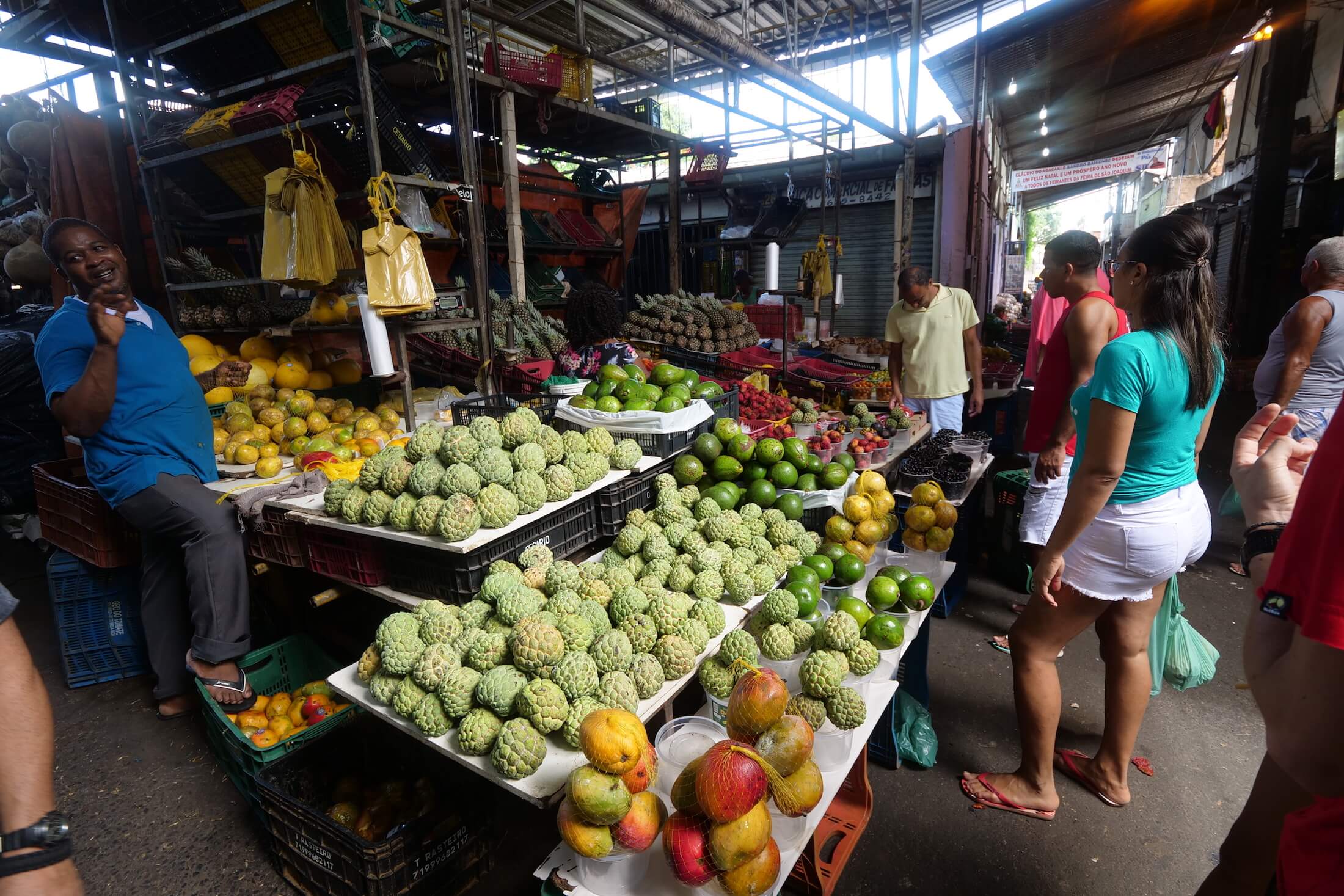
Your Day Begins in Salvador
You’re waking up to a full day of exploring Salvador, and in this case, I’m slightly jealous of you already.
730AM – There’s no single part of a city that will give you such a multi-sensory, educational (and delicious) introduction to a new place, wherever you are in the world.
I always enjoy starting any city tour with a visit to a fresh market. In my experience, visiting a local fresh market is definitely one of the best ways to quickly get to know a place.
In Salvador, São Jaoquim is a wonderful place to start.
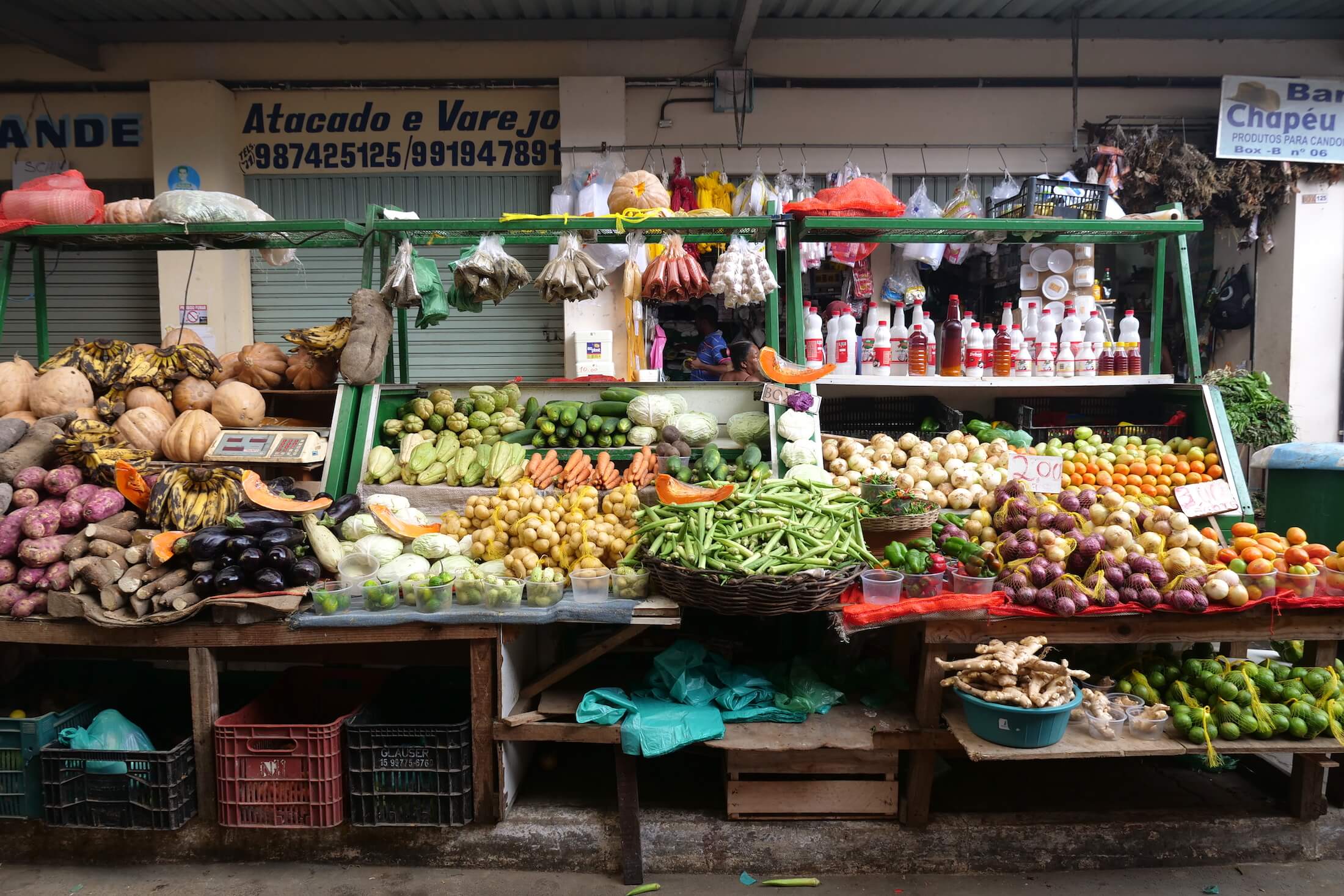
Sao Joaquim Market
You will never forget the powerfully sweet smells that hit you like a wave of jungle aromas, just seconds after entering this fresh market.
As for myself, I won’t forget the friendly smiles and ‘thumbs-ups’ that welcome you pretty much anywhere you walk in Salvador.
To begin our own street food tour of Salvador, we started in the morning at Sao Joaquim Market. By the way, watch the video of our day if you haven’t yet already, you can use the YouTube link here (link).
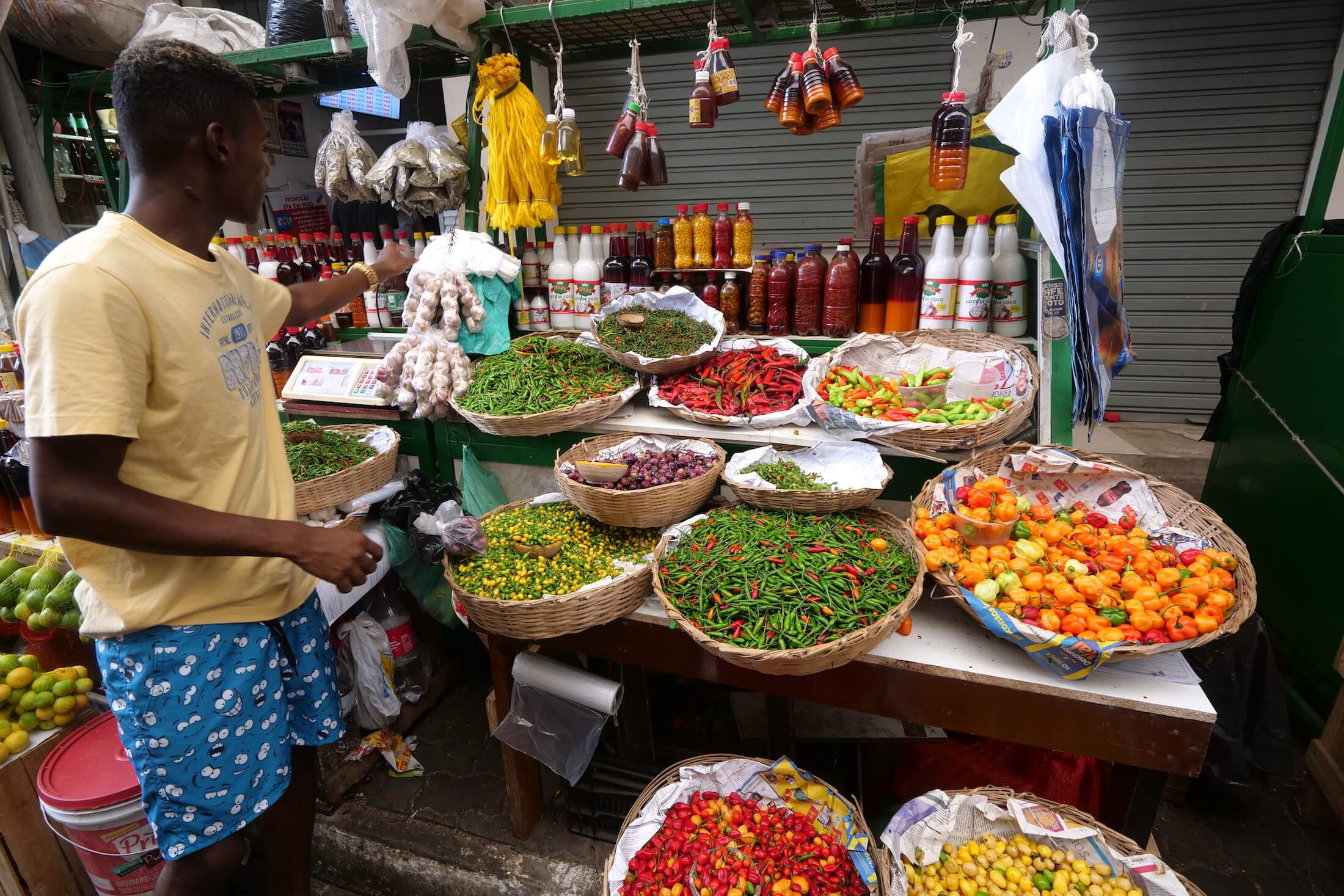
This Market has Everything
This market is full of local food, but as its also near the water’s edge – you can see ships bring in huge amounts of wholesale items here (there’s even a live animal market), as well as a huge area for tons of Brazilian fresh fruit.
This may also be your first introduction to the unique Afro-Brazilian culture of Salvador, which is a huge part of what makes Salvador feel so powerfully unique.
Surrounding the market center are shops selling dry herbs and spices, and many items relating to local Candomblé religious practices.
Recanto Da Lucia For Breakfast
8AM – Enjoy a morning coffee or soft drink at one of the open-air restaurants along the water’s edge, and take a moment to think about where you are in the world (I’m serious, open a map on your phone)
I hope that you came here hungry, because now is the time you should get excited for breakfast. The local food options at São Joaquim market are amazing.
At this time, I recommend that you stop for a gorgeously meaty breakfast at the small restaurant ‘Recanto Da Lucia.’
This meal at Recanto da Lucia was actually one of my favorite of the whole Brazil trip. The location, the atmosphere, the local morning market vibes here are classic – they are perfect and totally ideal for a Migrationology-style 8am meat-heavy breakfast feast.
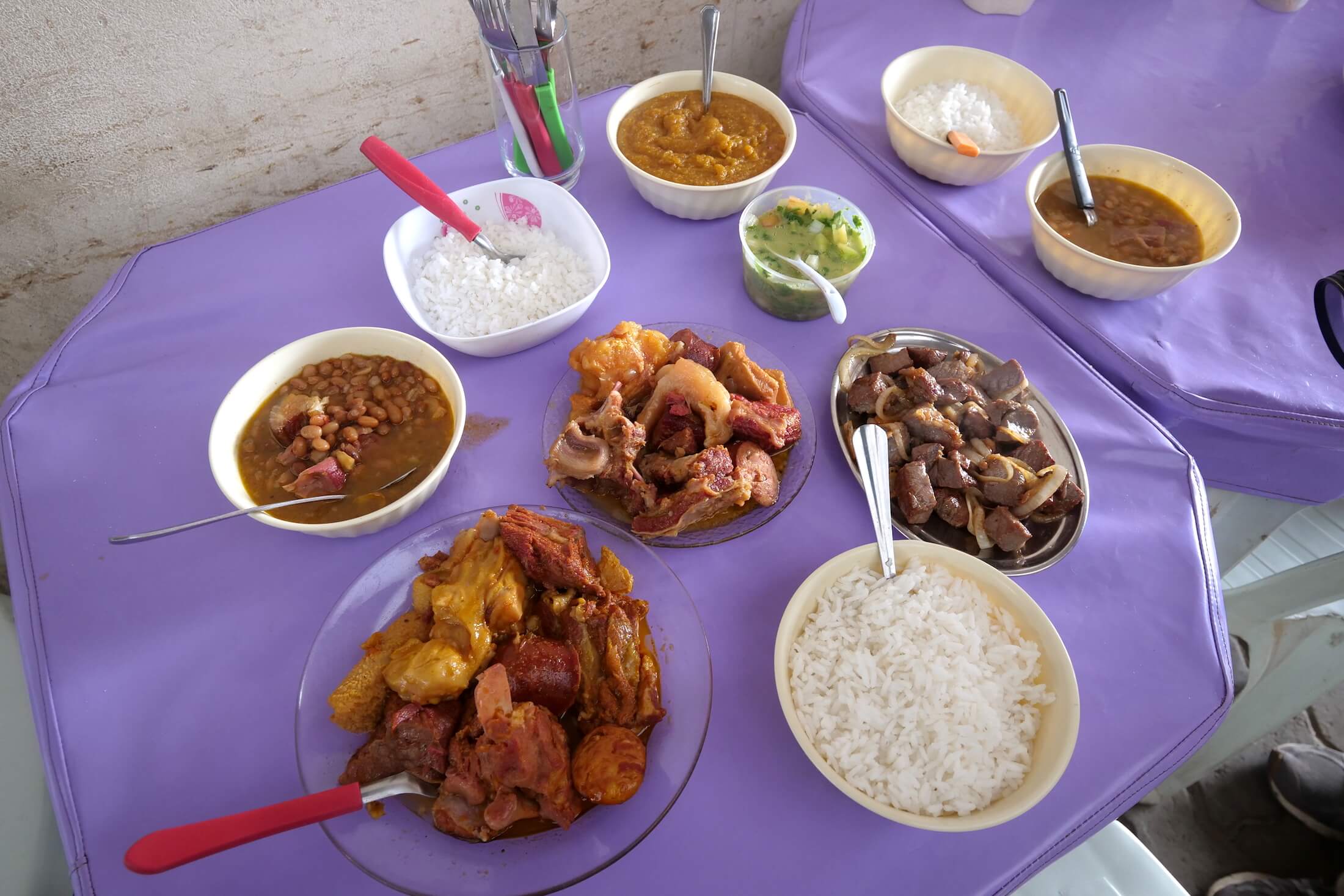
Name: Recanto Da Lucia
Location: Its not on Google Maps, but this is the Sao Joaquim Market Entrance (here)
Hours: No Hours Posted, but we came for Breakfast (around 8am)
Price: Our total bill for 4 people, came to 80 BRL ($20.61)
What Mark Ate Here
Order a plate of steaming beef tendons and steak to share, which comes with a side of black beans, and a small salsa-like salad. Follow this by ordering fried beef liver and onions, and don’t forget ask about their pirãu (a local delicacy made with dendê oil and cassava paste, sometimes its not on the menu, but you need to have this food here).
They will serve some incredible spicy and sour dipping sauces to go with these two main dishes of meat, as well as plates of white rice, and a shaker of cassava powder that’s been fried with pork fat (farofa).
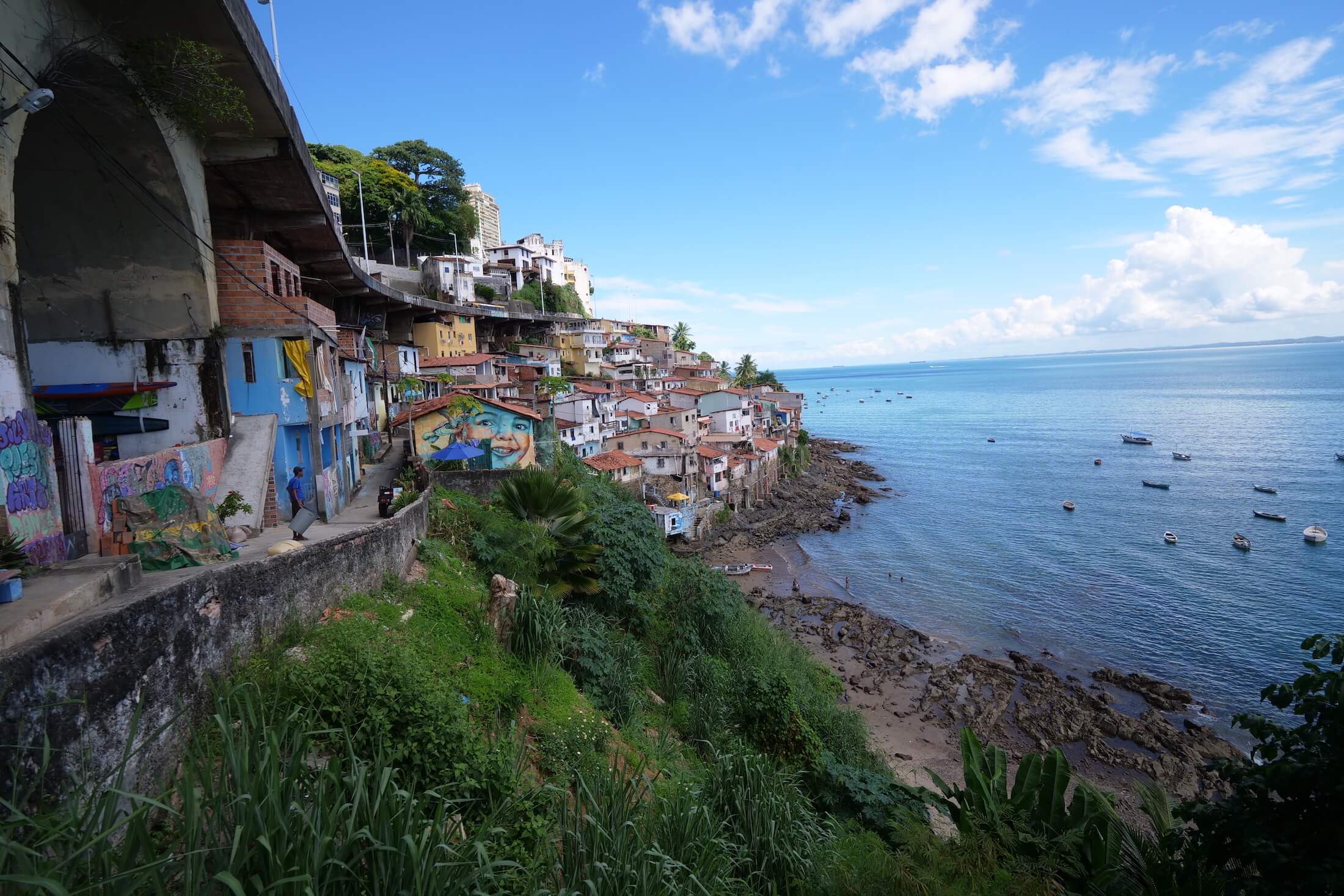
Quiet Local Beaches
9AM – Salvador is on a peninsula, and so it is almost completely surrounded by either rocky outcroppings and small scenic cliffs, local fishing spots, or wonderfully quiet beaches (like this one).
I love how you can find examples of both very modern, but also hundreds-of-years-old Salvador history, directly next to each other, sometimes even directly on top of each other here.
Be Careful Going Down
Getting down some tricky sets of stairs to visit one such beach location, I will still say it is well worth the journey – this is a way you’ll experience yet another side of this amazing city of Salvador.
In the photo below, you can see an old chapel, which is built directly next to the beach in the photo above. The building was a chapel, then a sugar mill, and later a museum, and is a piece of Salvador’s history that’s being kept in beautiful condition.
Get exclusive updates
Enter your email and I’ll send you the best travel food content.
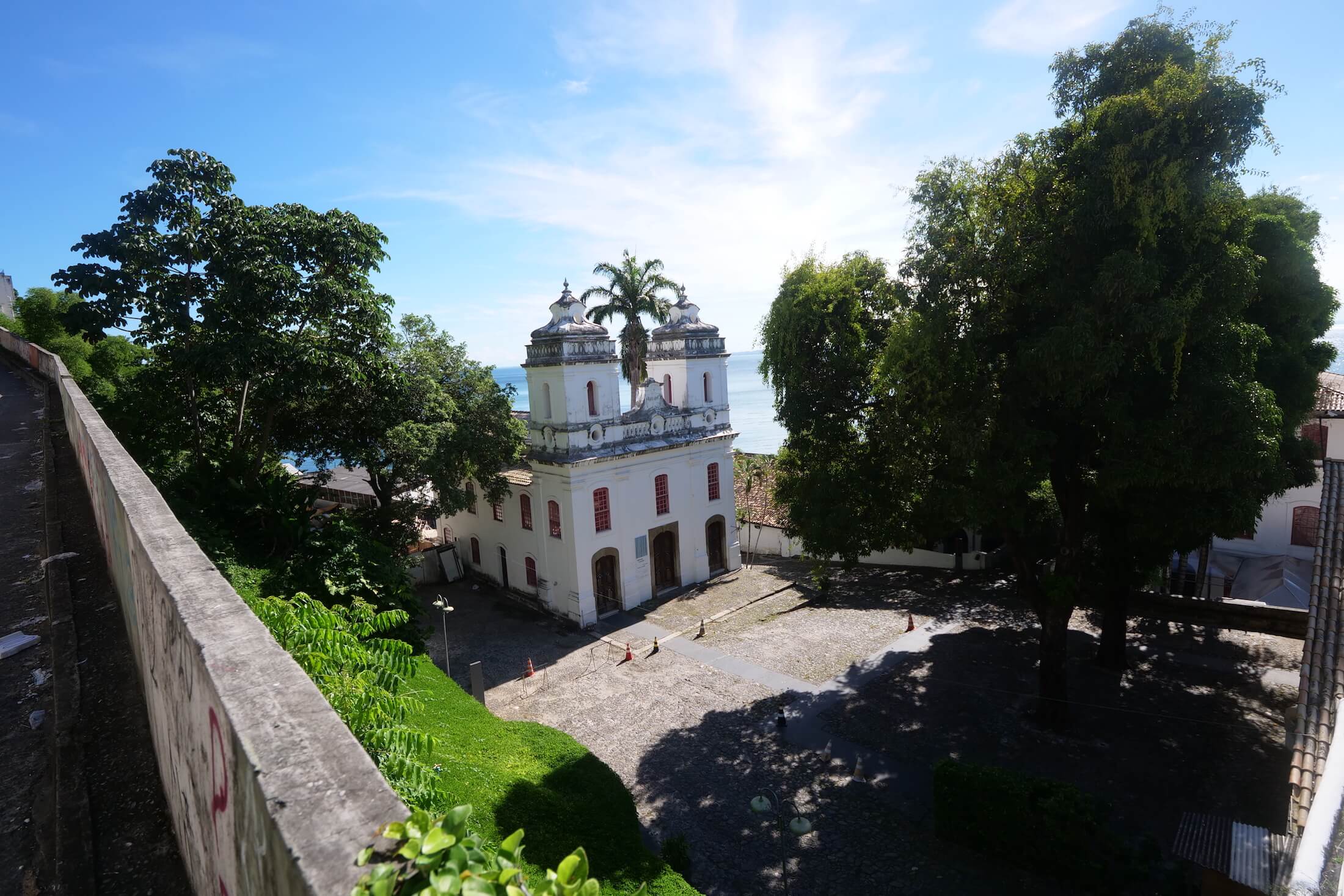
Solar do Unhão
One of our favorite meals in Salvador took place just a few hundred meters past this chapel – you should check out the entire article (here) of that incredible lunchtime feast of Salvador seafood.
We didn’t actually go inside the Solar do Unhão museum (we came for an early lunch to Ré Restaurante de Suzana on another day, and the Solar wasn’t open yet). As we were passing through, walking above this place on the cement barriers though, we couldn’t help but notice its beauty.
Beautiful (and Quiet) Local History
The chapel-turned-mill-turned museum is not open for very long each day, so we would love to go back for another visit.
If you have the chance, here’s the information on the Solar do Unhão, and leave a comment below telling us how you enjoyed your time there.
Name: Solar do Unhão
Location: Google Maps (here)
Hours: Tuesday to Saturday 1pm to 6pm, Closed on Sunday and Monday
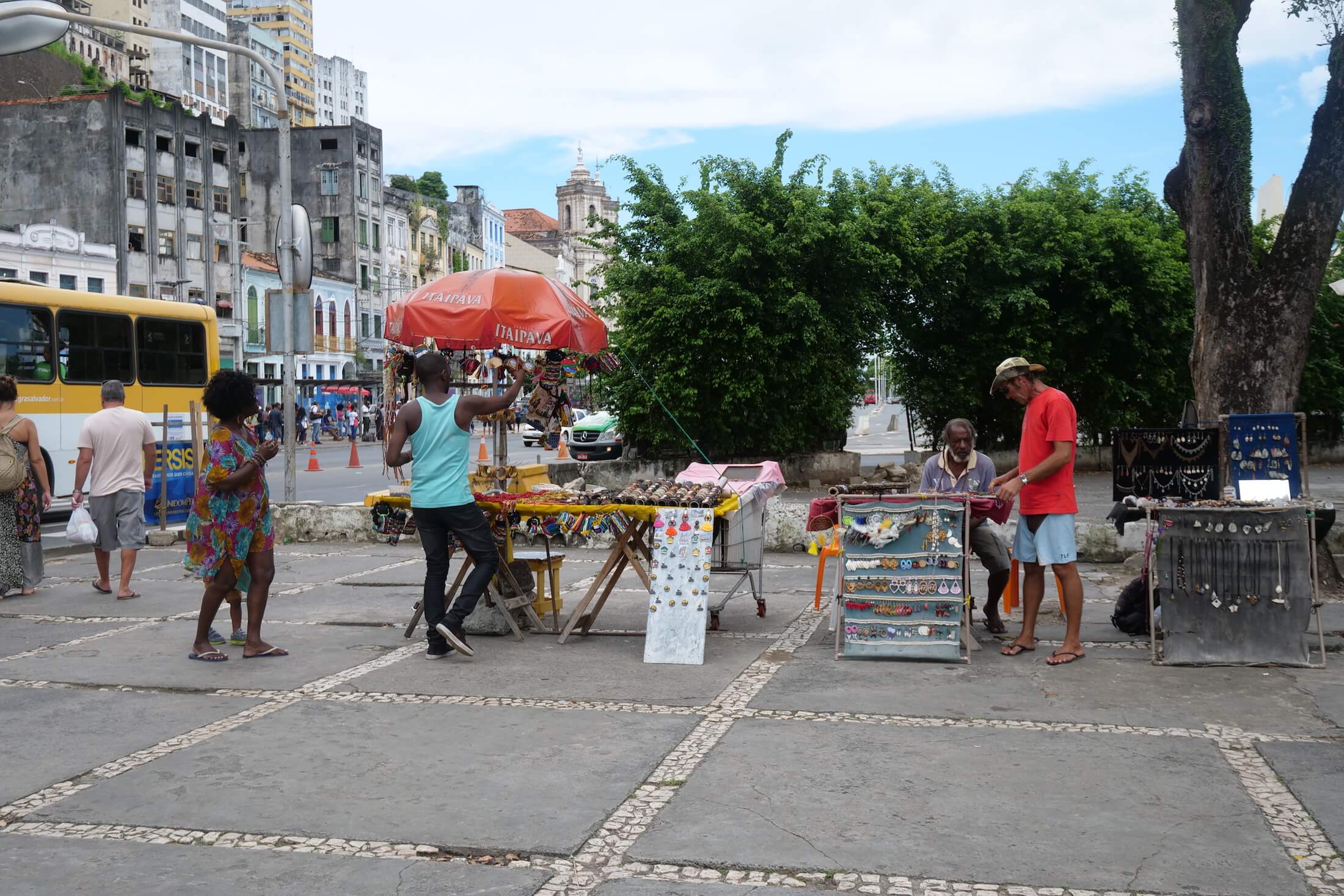
Mercado Modelo
930AM – Next up, on the way to visiting the old town area of Salvador, stop at the Mercado Modelo for a quick drink of fresh coconut water, a chance to buy souvenirs, or even a delicious second breakfast.*
Just 1 km north of the Solar de Unhão and its picturesque beach community nearby, Mercado Modelo is also located right along the bay that borders Salvador.
Although it can be quite touristy, this really is a great location to buy souvenirs to bring home (the market was quite busy each time we passed during the week), as well as being a central transportation location if you enjoy traveling by local bus around Salvador.
Snacks and Food at Mercado Modelo
If you’re not interested in anything but the next meal, walk behind the shops to find some more awesome examples of Salvador local food.

Jacibar Restaurant
While this won’t make the list of the five best things to eat in Salvador (at the bottom of this article), Xinxim de Galinha is definitely an amazing Brazilian food, and surely something that you have to eat at least once during your time here in Brazil.
Surely too, this is a food that you should think about having right now for your second breakfast today in Salvador.
Walk through the market and take a right, find the small row of kitchen type kiosks called ‘Jacibar Restaurant.’
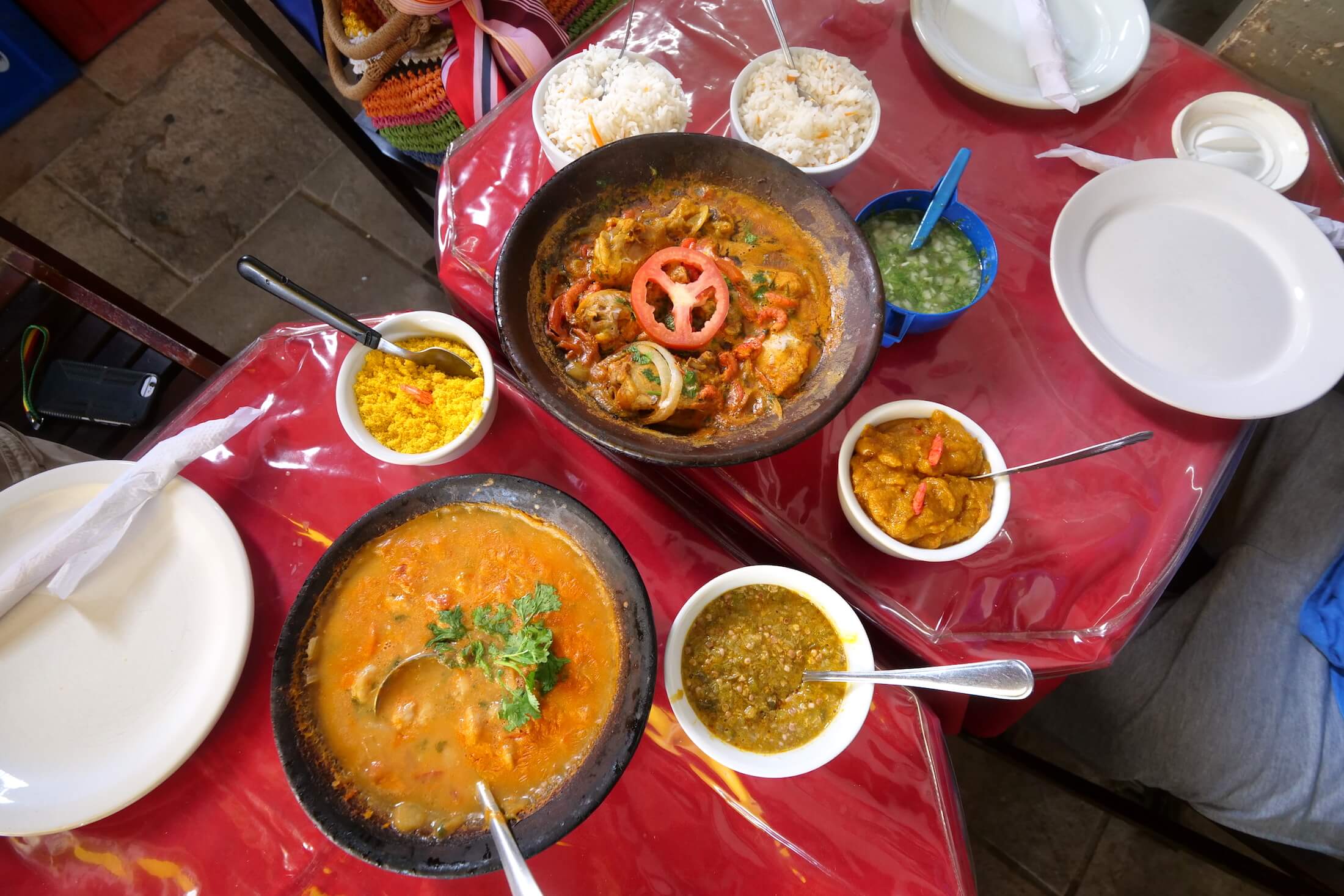
What Mark Ate Here
While the rest of the market is pretty touristy, there are many delicious local dishes to be found with Senora Jacy (Jacibar).
Besides Xinxim de Galinha, the bobó de camarão is delicious, and also the caruru. An incredible meal, and very cool to see how the atmosphere and vibe changes so much, sitting in basically an indoor alleyway just meters from such a touristy area.
Name: Jacy Restaurant
Location: Google Maps (here)
Hours: Open Daily, 7AM to 4PM, Closed on Sunday
Price: Our total bill for 5 people, came to R$180 (US$45)
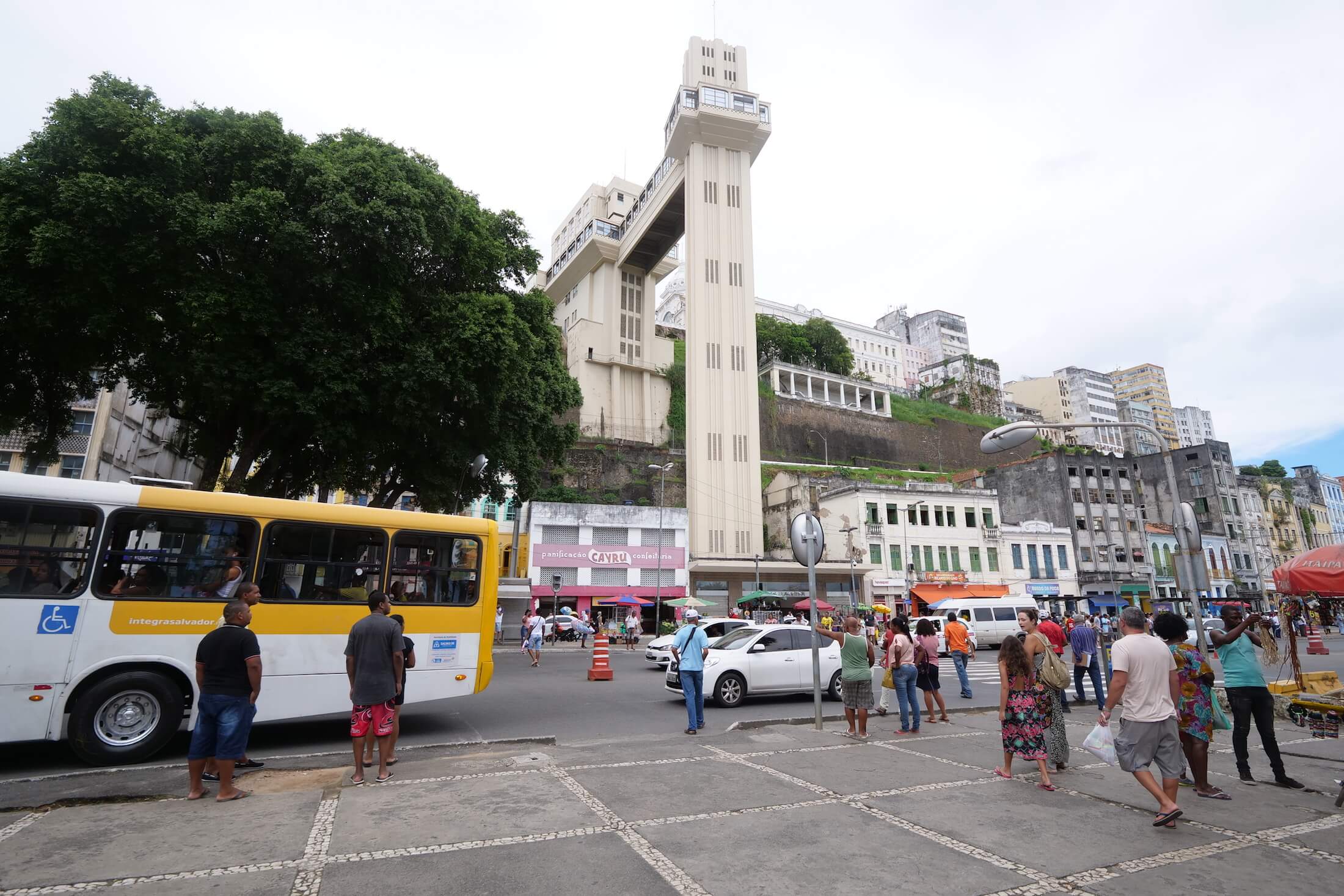
Lacerda Elevator
11AM – Walk directly across the street from the Mercado Modelo, and travel about 80 vertical meters upwards in this elevator that’s over 100 years old.
An old elevator, and yet very much still in use, this is a well-loved piece of Salvador’s history. The Lacerda elevator connects the lower and upper city areas, and wow – what a view from the top!
I think this is one of the cheapest entrance fees I have ever paid anywhere (without it actually being free), as each passenger costs R$.30 each way (US$0.08).
The lift itself has no windows, but there’s a long set of them inside the entryway, and the view overlooking Salvador here is incredible.
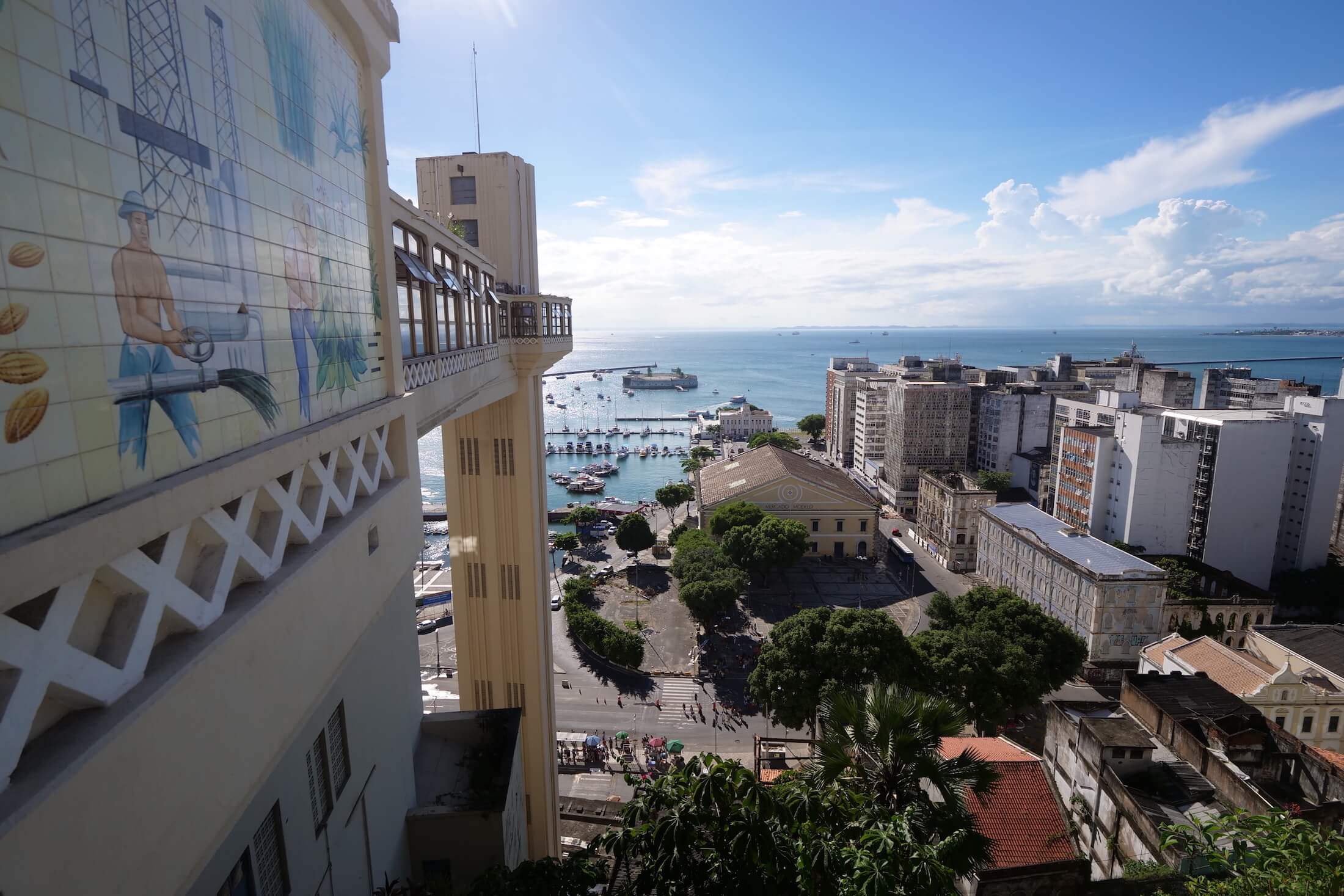
Coffee
1130AM – Any chance to stop and have a cup of fresh Brazilian coffee is welcome, especially when it comes with a view like this one.
Most of the coffee in Brazil comes from the Central Southern state of Minas Gerais, but the state of Bahia grows plenty of delicious coffee as well.
Have your second (or maybe your third), cup of coffee for the day here, look out over Salvador and the waters that surround it, and dream of the delicious seafood that you will be eating later today.
If coffee is not interesting to you, then this could be a good chance to try Brazil’s iconic soft drinks – the Guarana drink made by Brazilian company Antarctica is very sweet and has a unique taste as well.
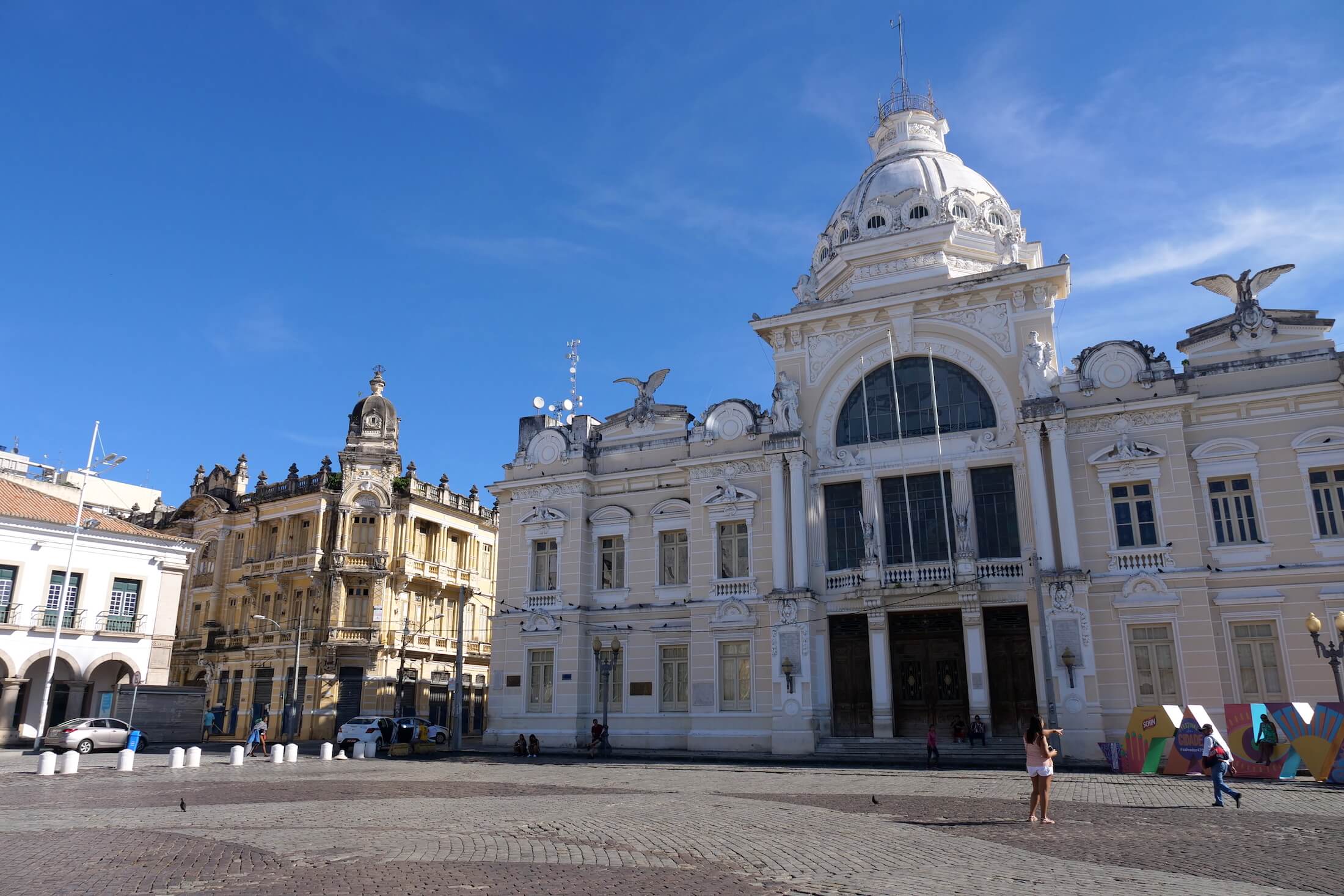
Pelourinho
Note: This could be your starting point for Part 2 (or a second day) of things to do in Salvador.
NOON – After a gastronomic introduction to life in Salvador da Bahia, you should make your way to learn a bit about the historic area of Salvador as well.
Exiting the Lacerda elevator, the area you are now entering is Pelourinho.
A beautiful area here, and an older part of the city, this area is full of hostels, nicer restaurants and cafés. You’ll find tons of local streets snacks in the incredibly narrow streets, and an abundance of great photographs waiting around every turn.*
Here you can also see demonstrations of Capoeira martial arts, Olodum drumming practice, and on the way you’ll almost feel like you are in Portugal – the streets and architecture here have so much obvious European influence.
*Note: If you have a rental car, be prepared for some tricky driving and parking, the streets here are extremely narrow, and some of the roads quite steep.
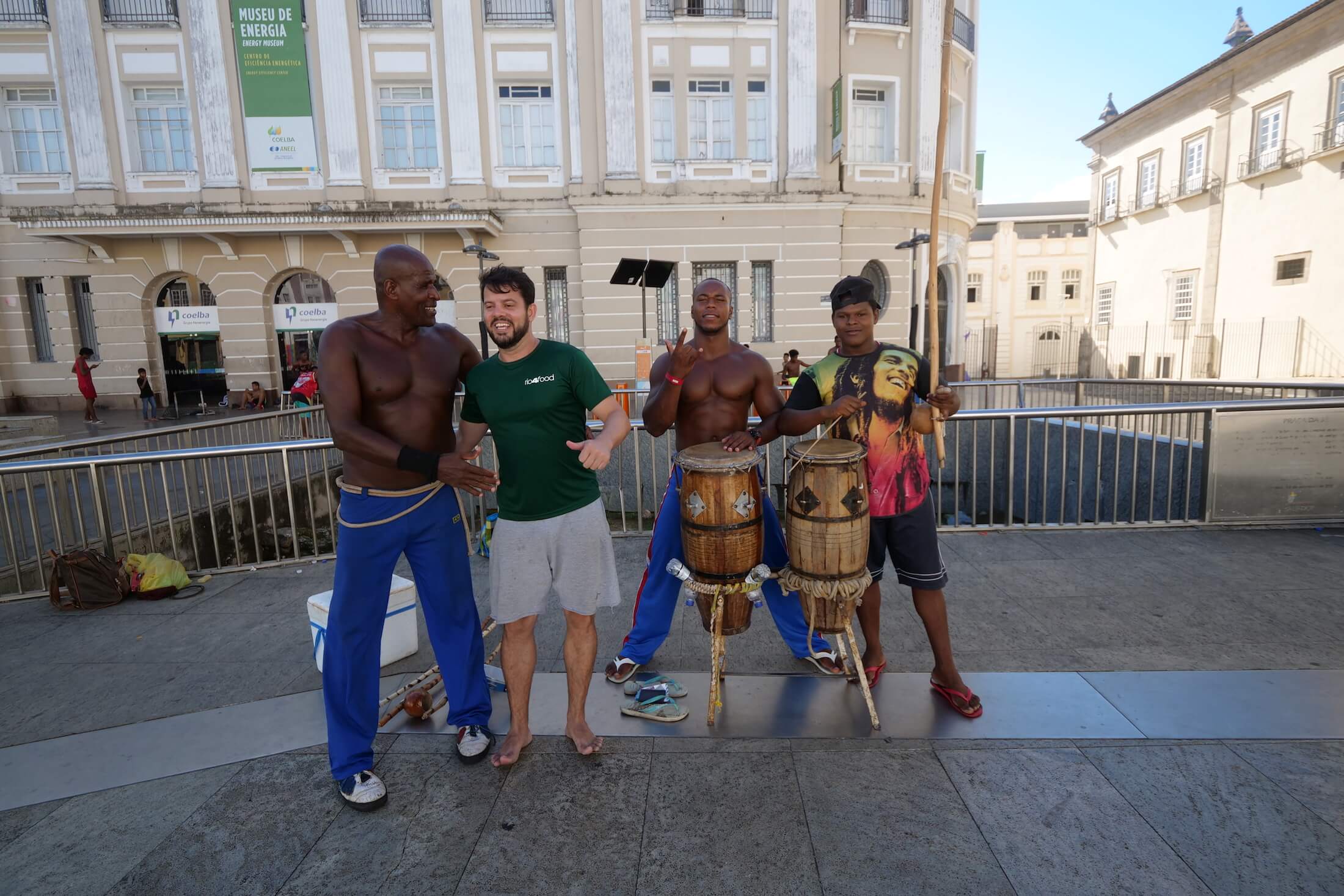
Capoeira (Martial Art)
Part of the unique culture in Salvador, and something you absolutely cannot miss while you’re here, is seeing a performance of the Brazilian martial art of Capoeira.
This unique and complex martial art was developed by African slaves who had been taken to Brazil in the 1600s. It is quite acrobatic, one could almost think that they are dancing, and the movements are mesmerizing to watch.
You can sit back as a spectator, enjoying the music that accompanies a practice demonstration like this, or feel free to ask if you can take part as well.
Note: There is no fee, we found this group practicing in a public area. Of course, as performers doing this for their daily living though, they appreciate tips if you enjoy the show.
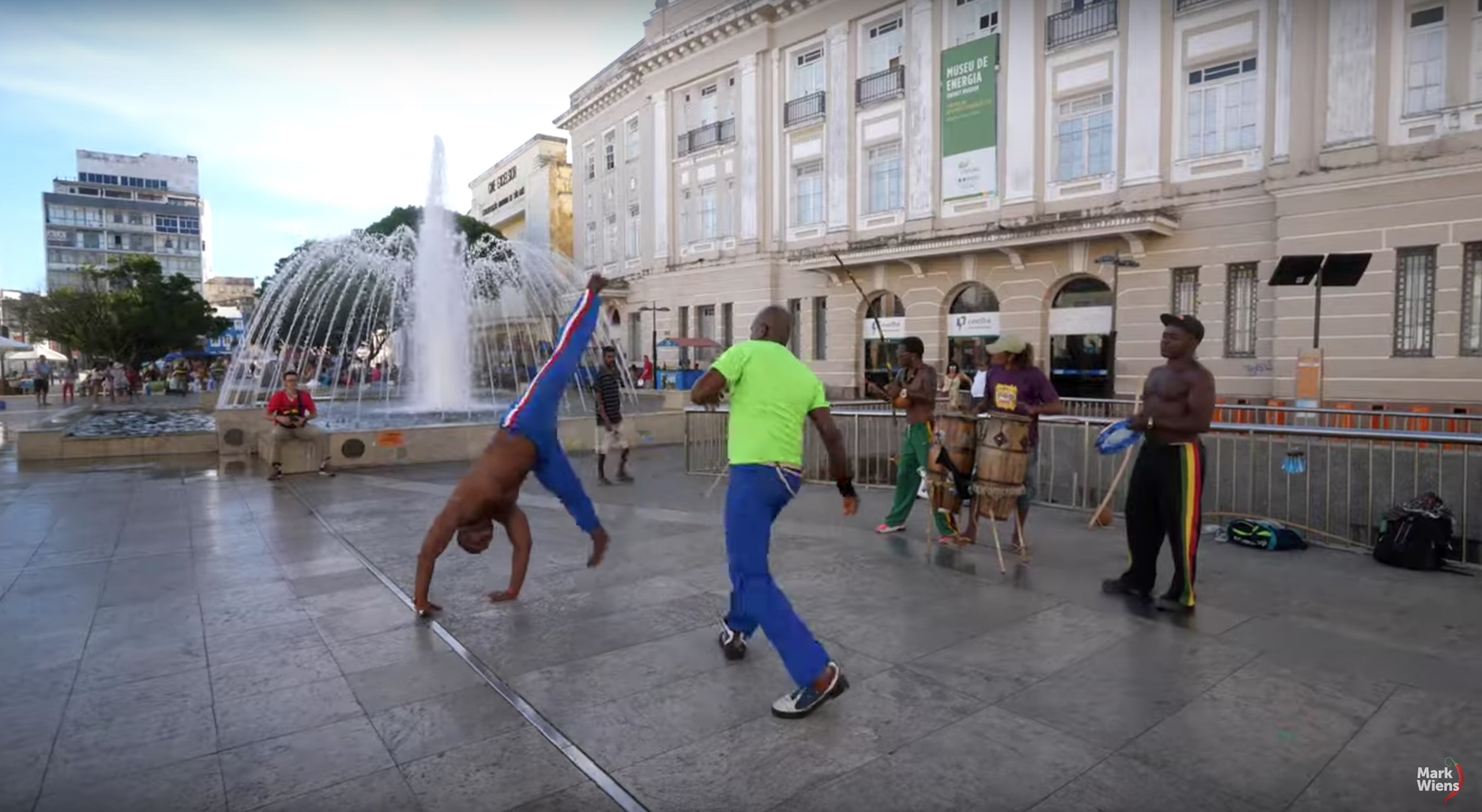
The Roda
What you see here is not a fight, but a practice session – a ‘Roda.’ This is also how the martial art of Capoeira was disguised in the past, and practicing this way includes music and simple singing, and one very unique instrument which determines the rhythm of the Roda.
As slaves developed a way for themselves to practice without needing to hide, they could stay fit, while also being a part of something, overall giving themselves something of their own of which they could be proud.
Local Martial Arts in Brazil
Like most martial arts, there are of course many groups of people who practice this very seriously, and would seriously injure you, were you to attempt to join in.
I think it is so cool though how there is also this other side to this martial art of Capoeira, one that is fun, musical, and so unique. It is welcoming to a spectator experience, and if you have a chance, I recommend trying it out for yourself.
Here’s some info on the ‘Berimbau‘ as well, such a cool and unique Brazilian instrument, read a bit to learn how incredibly complex practicing the Capoeira rhythms can be – its incredible.
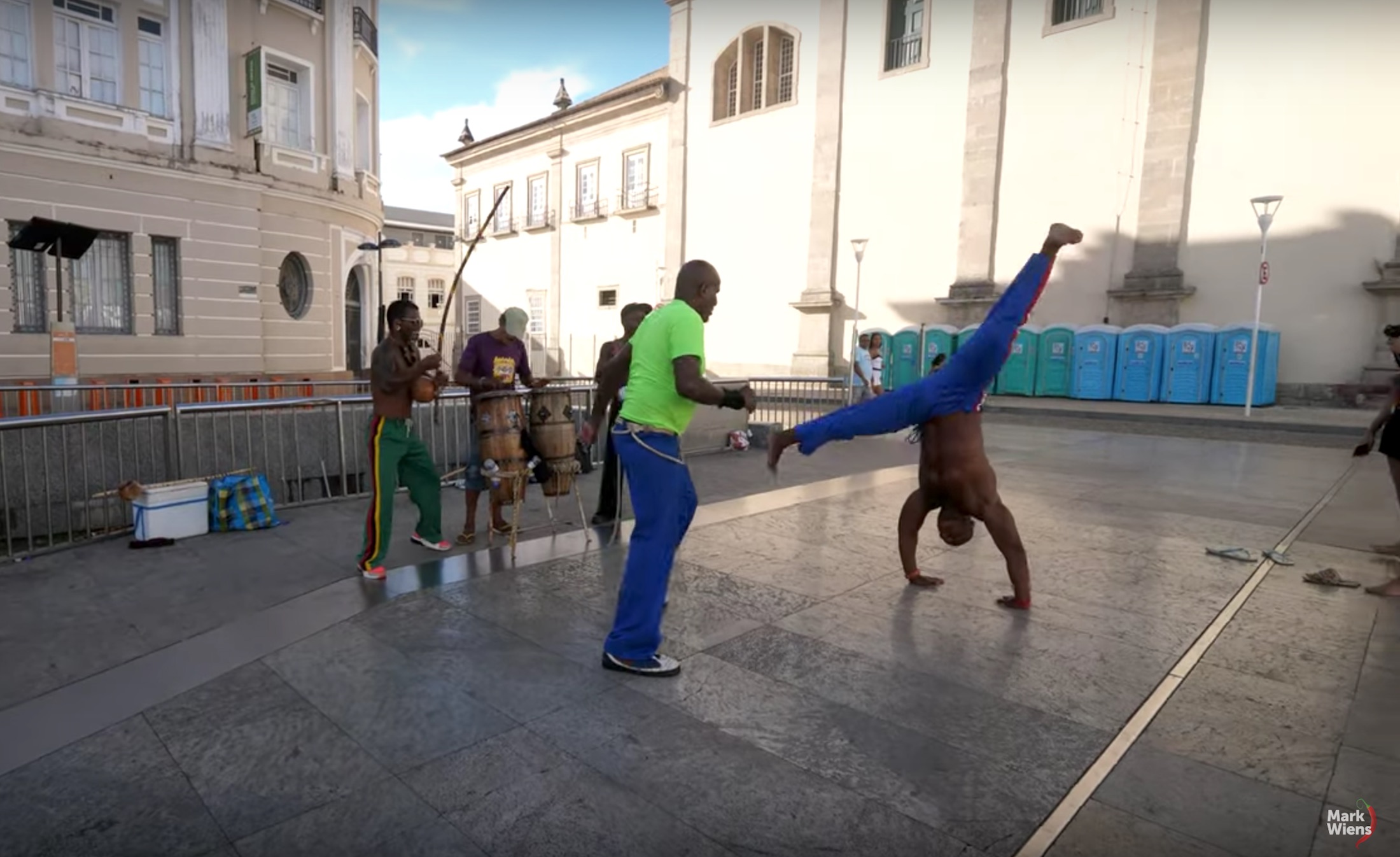
Centro Histórico (Historical Center)
Besides the incredible displays of love for their local traditions, this is the area where the people of Bahia will direct you when you want to find churches, museums, and the beautiful examples of local architecture, spanning across the years of both colonial and modern Brazil.
We did not take very much time to explore around in this area, but it is very obvious that one could spend many days here in the Historical Center of Salvador. This is likely the best place for those learning about the history of Bahia, and a great place to get a feel for the gorgeous diversity that the state of Bahia adds to the greater country of Brazil.
Name: Historical Center of Salvador
Location: Google Maps (here)
Hours: Open Daily
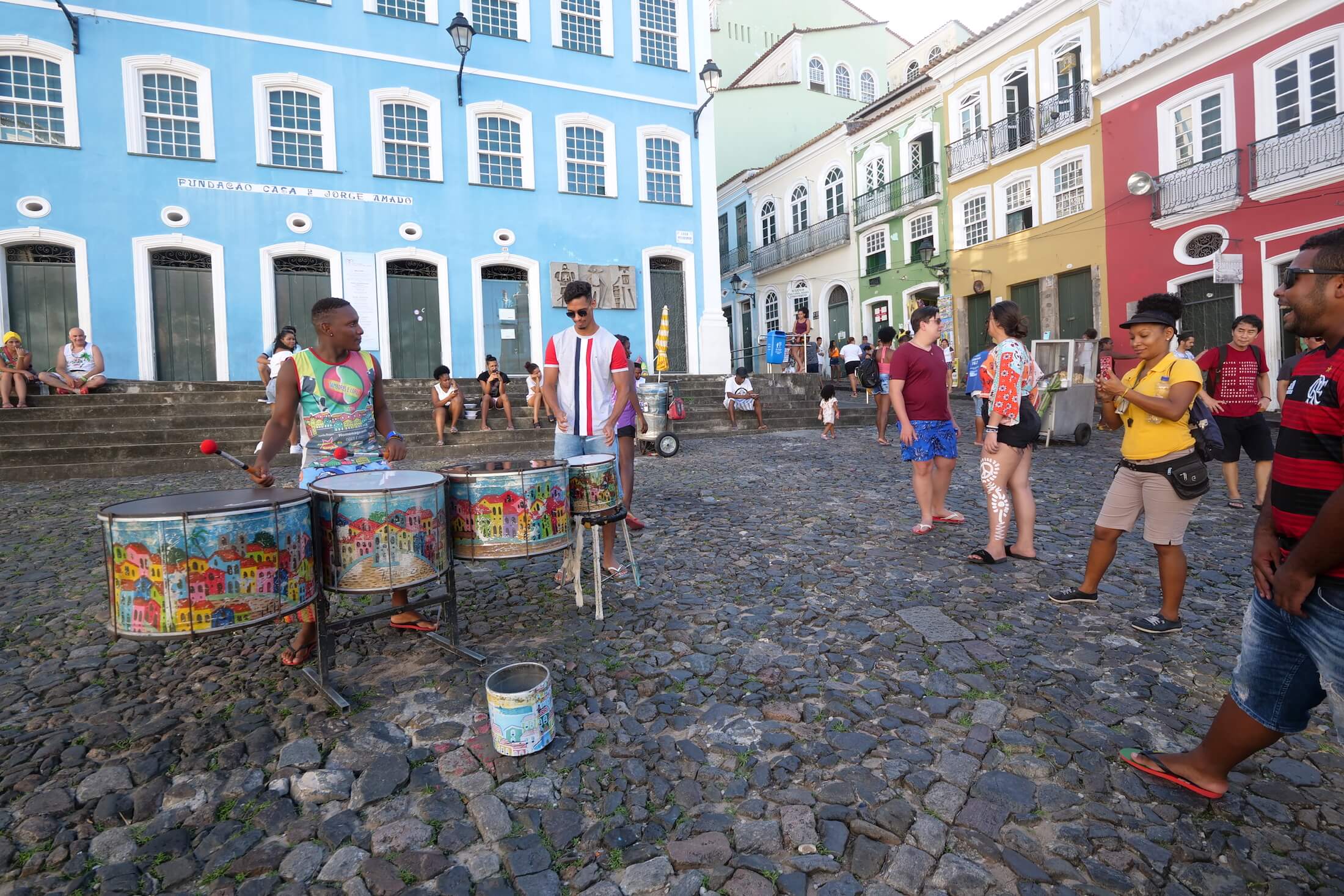
Olodum
130PM – Featuring mostly drums and rhythm, followed by dancing and finally singing, Ololdum is a unique type of music and a huge part of the state of Bahia’s modern culture (wiki article here).
Definitely one of the most well-known things about Salvador, the local Olodum music tradition was one of the things we were most looking forward to seeing for ourselves.
Near the historic area of Pelourinho (mentioned directly above this section), you can watch at least a small group of people who are involved in Olodum, practicing drumming rhythms every day.
Salvador’s (and Brazil’s) Love of Music
If you want to see the full Olodum carnival performance however, you are going to need to visit Salvador in January of February. Traditionally, each Tuesday is treated as a full practice day, and if you’re wondering why it takes so much organizing, you can check out a video here.
Carnival is one of the most amazing things in all of Brazil (the video above is only the Salvador carnival, Brazil’s Carnival (in Rio de Janeiro each year) is even larger!).
In my opinion, what on earth could be more cool than people getting together to cheer and support musical performance with the same passion that most people cheer for sports? Of course Brazil has great athletes as well, but its their love of music which is so amazing and wonderful, and it is something in our world about which we all need to learn more.
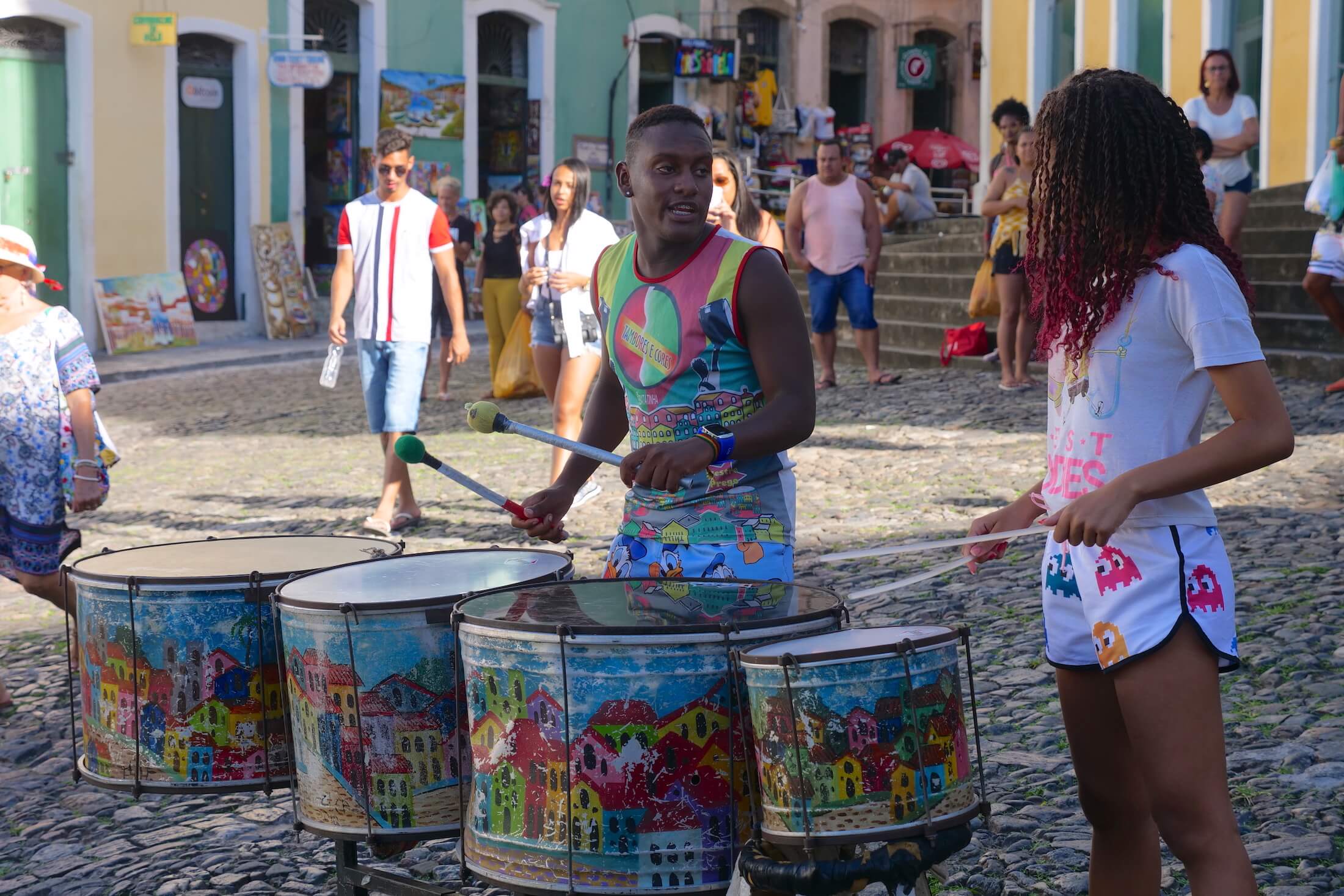
A School of Music and Tradition
Olodum is more than just a single music event, and it could be called a ‘school of music tradition.’ Basically, Olodum hopes to be the culture, ideas, and traditions of the state of Bahia in music form.
It has grown over the past 50 years (since its creation) into something that has transformed the entire local community of Salvador, as well as gaining fame almost worldwide. What started as group performance in Rio de Janeiro’s Carnival, Olodum exists now with a purpose of promoting and educating about Bahia’s history, culture, art, and gives a voice to the identity (and pride) of what it means to be from Bahia.
Final Notes Before Moving On
Salvador, Bahia, in Brazil, is a place that will undoubtedly exceed expectations. The food and people are outstanding, and will always make it one destination you will never forget.
What a stunning combination of natural beauty, food, and hospitality.
Note: From here, the time can be adapted to your own schedule, Each of the five food listed below comes with information on where and when to have it, but the order is up to you.

5 Best Foods of Salvador
Of all the wonderful things about this amazing city of Salvador, my favorite has to be the incredible Afro-Brazilian food culture.
Literally blooming from every street corner in town, this truly is a unique place in our world – there’s simply nowhere else like Salvador when you visit Brazil to travel for food.
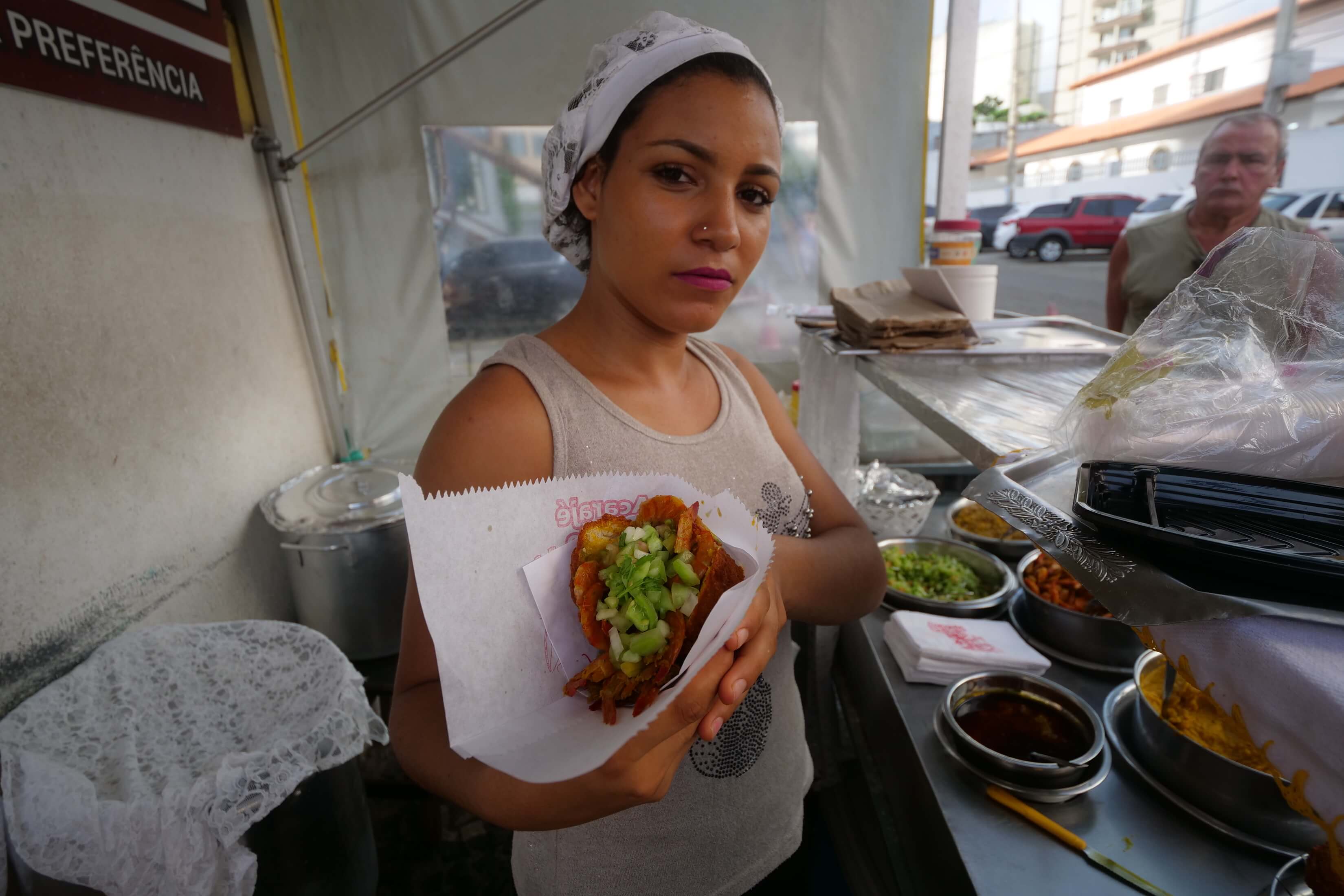
You Really Should Try All 5 of These Foods
The following list is not in order, all of these foods are incredibly good, and all of them are worth a trip to Salvador just to eat.
You will find information about when and where we recommend having each food, and if you do want to have all of them in a single day (which is possible), then please let us know how you enjoyed yourself by leaving some words in the comment section below.
Finally, we think that these are 5 dishes that will give you the most real and lasting memories of your (delicious) time in this incredible part of our world.
Enjoy.
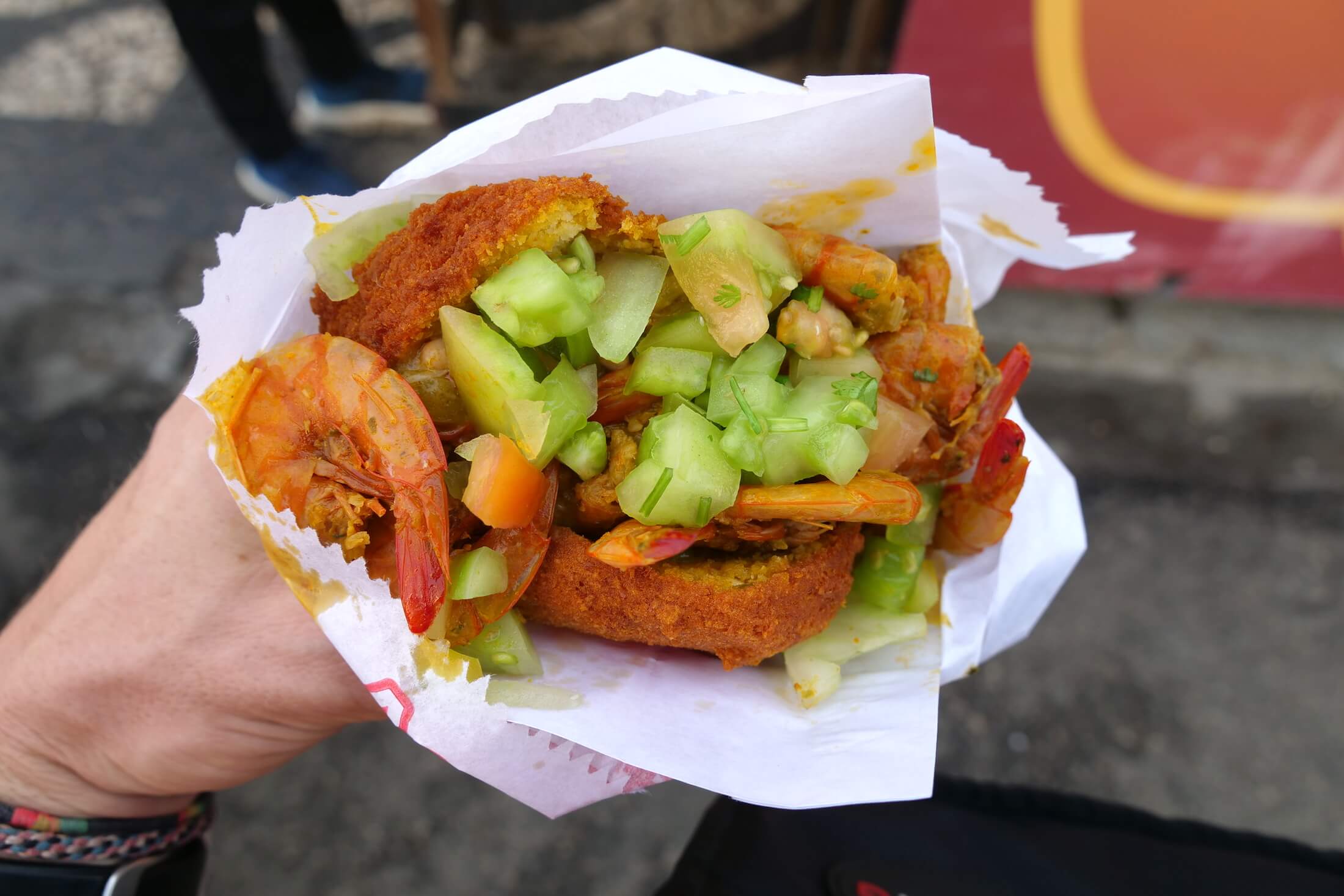
1. Acarajé
Acarajé is without a doubt one of the best and most ultimate street foods in the entire world.
To paraphrase a chef friend’s statement during a previous trip (traveling for food in Asia), “you haven’t actually been to Salvador, if you haven’t eaten Acarajé.”
There’s no way you can visit Salvador and not allow your mouth to be completely blown away by this food.
What Is It?
Starting off by deep-frying black-eye pea cakes in red palm oil (dendê oil), the acarajé-maker packs each sandwich-style patty with a selection of local delicacies. You choose between some thick pastes of okra and cassava, the chef adds in some green tomatoes, and don’t forget the chili oil, and maybe a few entire chilis.
You’ll get a wonderful gentle crunch each time you bite through the outer fried patty, and the delicious warmth mixing together the mushy vatapá (the cassava paste), the gooey cururu (the okra paste), and those entire salted shrimp… it’s actually difficult to put into words how happy your mouth will be.
The onions and cilantro finally come in with the green tomatoes to add brightness to each bite, a squeeze of lime makes the tongue tingle, and finally the slow burn from the chili and chili oil just sets this food apart from all other contenders.
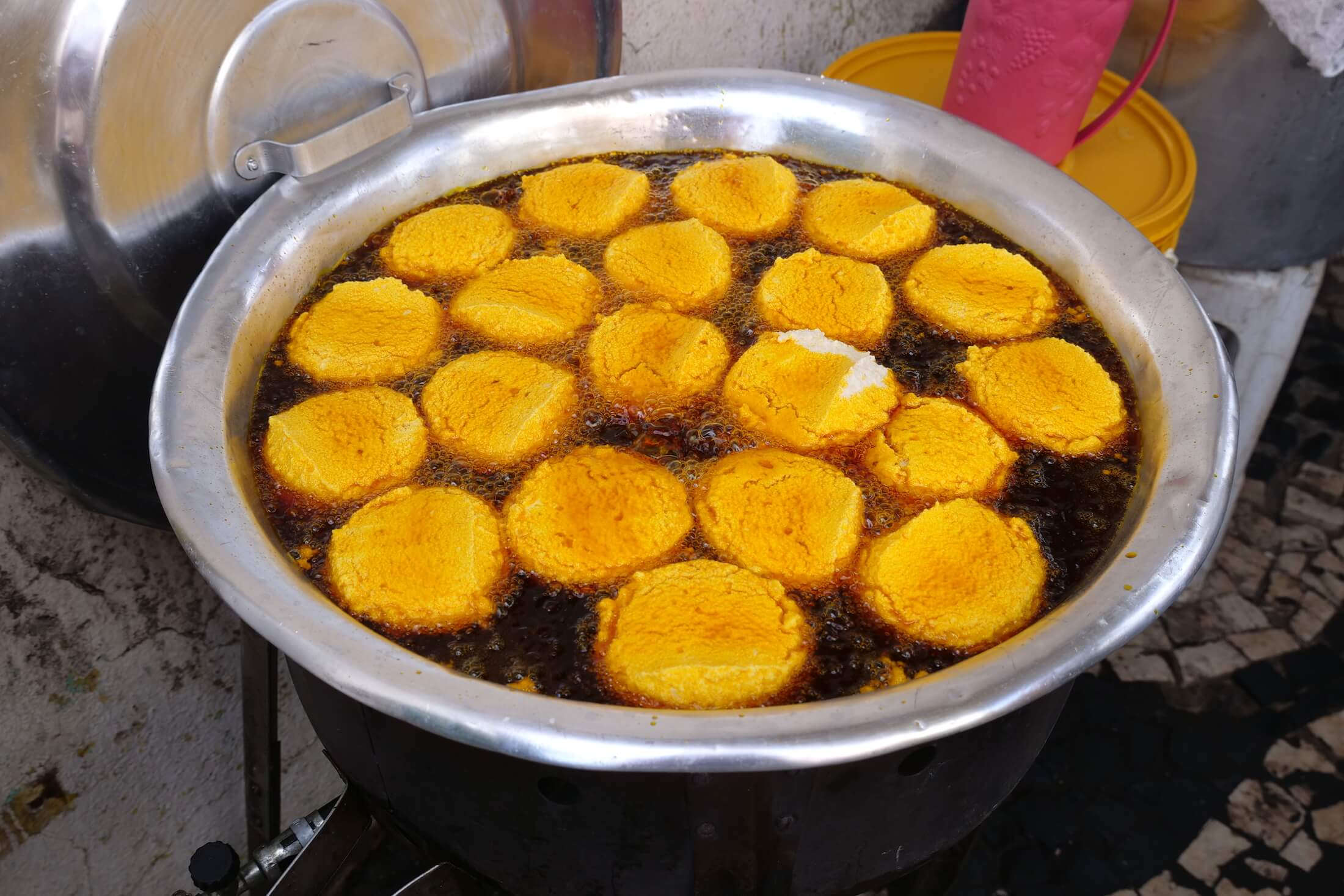
Where Do Brazilians Eat Acarajé?
If you’re in Bahia, you’ll probably find your way to Salvador at some point – and visiting Señora Ivone needs to be right at the top of your list!
She is famous, while still maintaining just the same single-station street cart. You can tell the dedication of her followers though, as we were there at least 15 minutes early, and we were definitely not alone!
Order (at least) one Acarajé with shrimp, and one Abará as well.
Name: Acarajé de Ivone
Location: Google Maps (link here)
Hours: Open Daily, 3pm to 8pm, Sunday 10am to 3pm
Price: R$6 for basic acarajé, up to R$10 for shrimp (US$1.50-2.50)
When to Eat Acarajé
This is usually an afternoon snack/meal in Bahia, so be sure to clear your schedule from about 4pm onwards.
If its your first time having Acarajé, you’ll likely find yourself immediately ordering seconds.
The powerful feeling of pleasure, just the heart-warming happiness that comes with eating this food, is a feeling that will stay with you a long time. I can’t think of many more handfuls of food in my entire life that left me with a more complete sensation of food happiness.
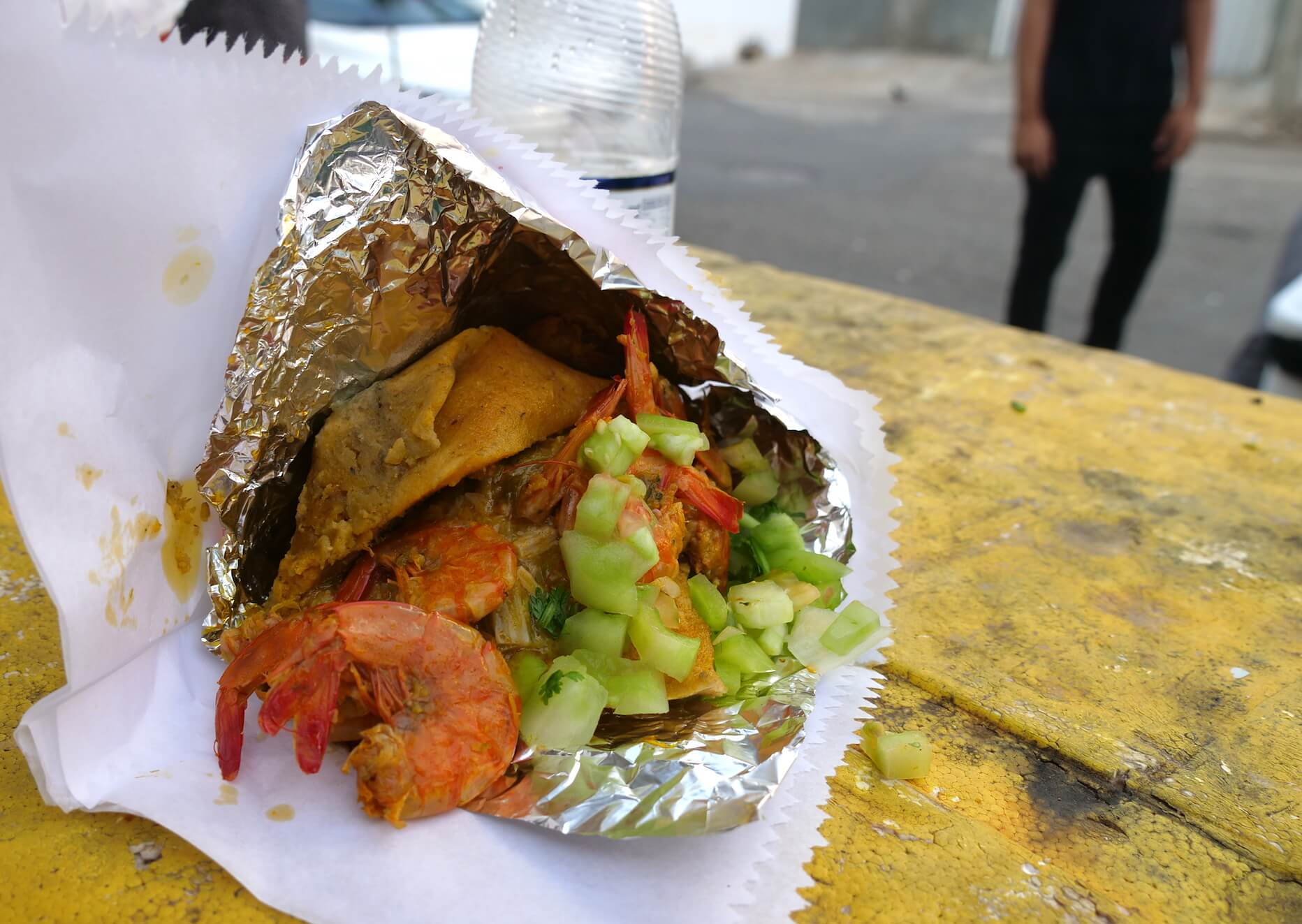
On your next trip to Brazil, visit the diversity of Salvador, Belo Horizonte, Curitiba, Manaus, Belém, Goiania, and Rio de Janeiro – these are all places that we visited ourselves – and experience love for Brazil through its food.
Bahia is an amazing place, and the next dish here you have to search for is Moqueca.
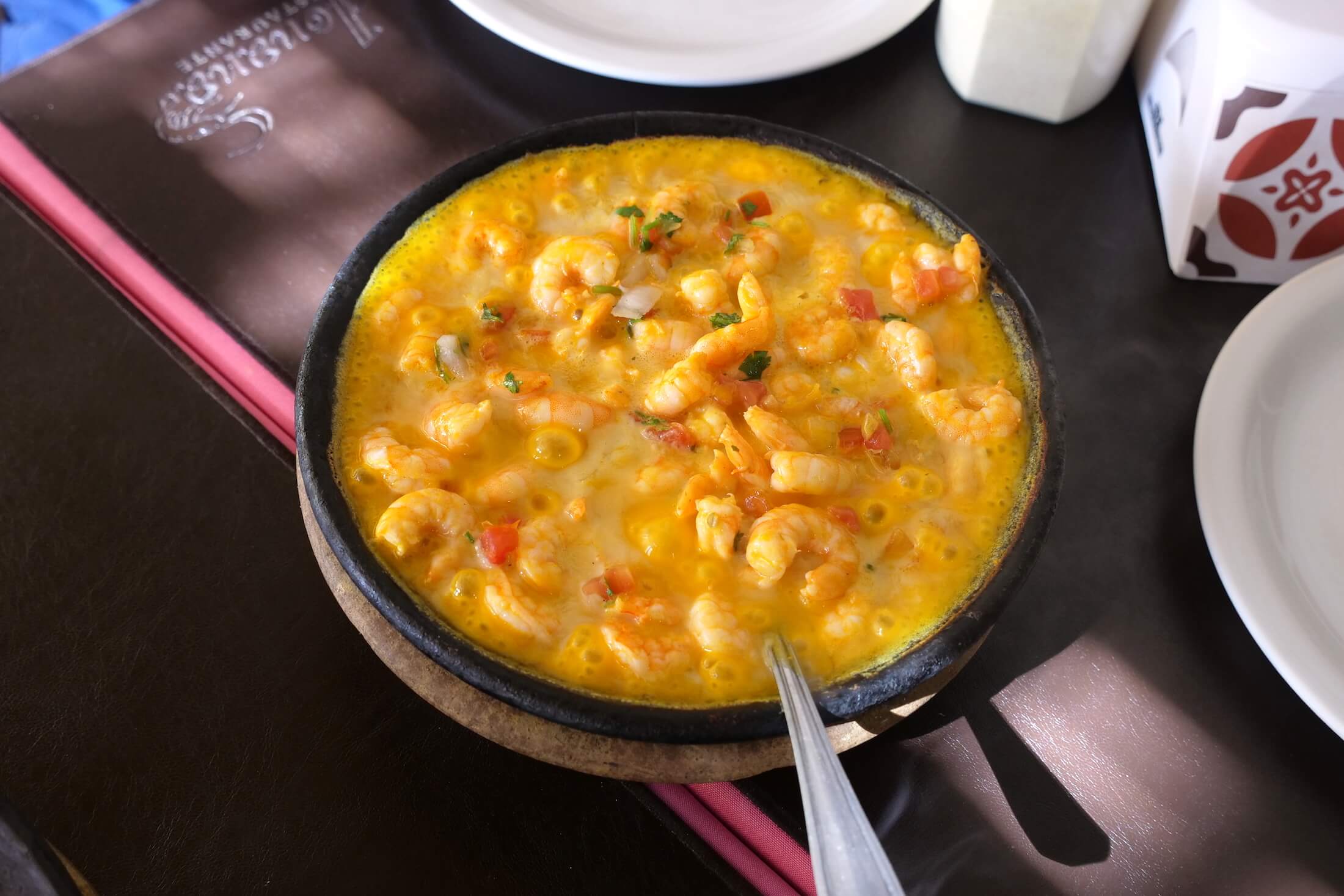
2. Moqueca
There are actually two slightly different types of Moqueca, one which comes from Espiritu Santu, and one from Bahia (the state of which Salvador is the capital).
Moqueca is the most famous dish from the region of North East Brazil, and a delicious food that you definitely need to have when you’re here in Salvador.
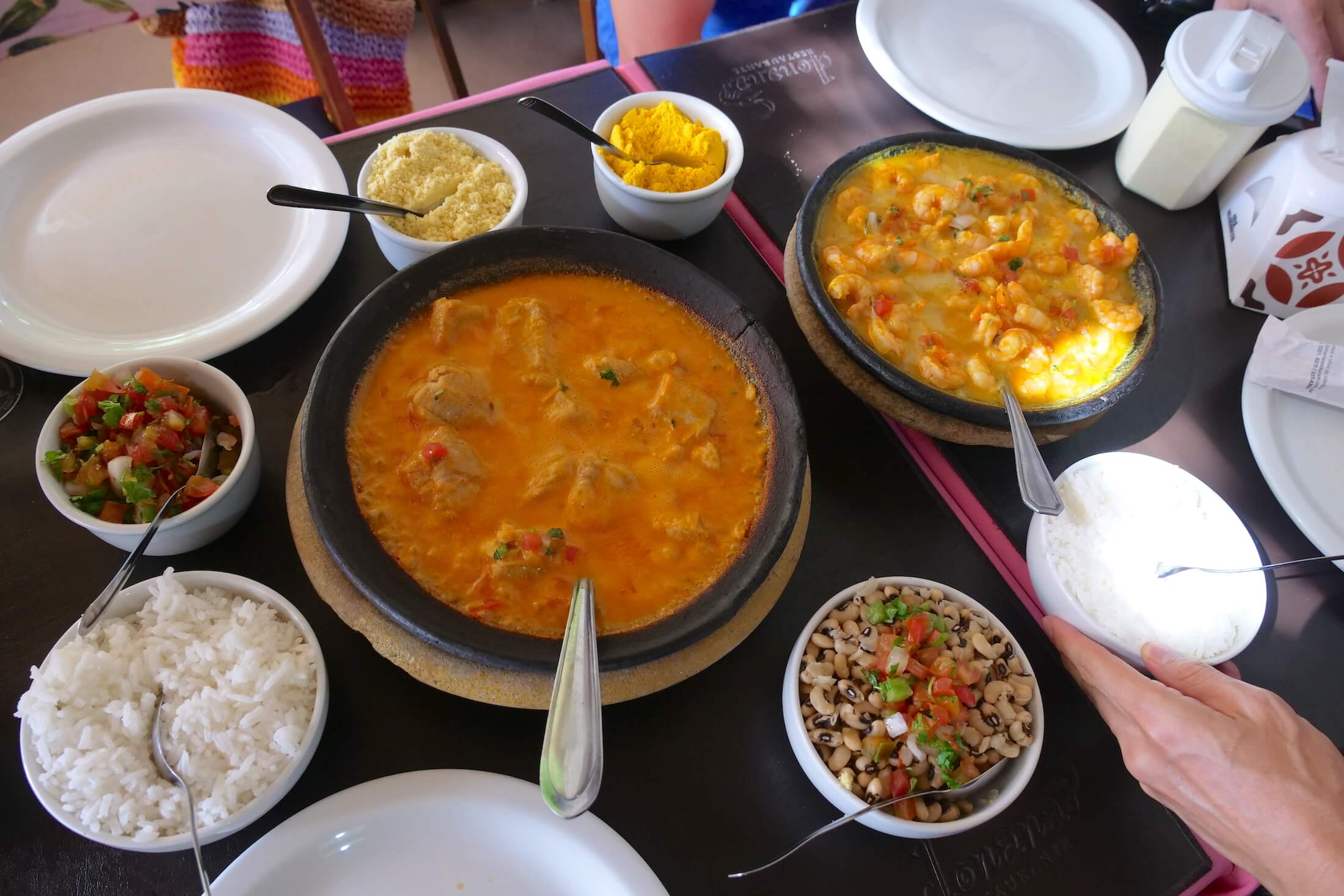
How to Eat Moqueca
Moqueca is traditionally a clay-pot stew of ocean fish or seafood, and tastes best when you have it as a main course item surrounding it with a huge spread of side dishes.
A common ingredient in Moqueca is shrimp, but as Moqueca in Bahia always cooks in this black clay vessel (thoroughly and wonderfully mixing the flavors together over longer, lower heat) they often choose to use a few other meats that might not be nearly as flavorful on their own.
Dry fish is common, as well as stingray, manta ray (like another version we had here) and you can really enjoy some true, traditional flavors of Salvador’s favorite food with a huge meal around a seafood stew of Moqueca.
It might look like a curry, but the rich color comes from healthy portions of both coconut milk, and red palm oil (dendê oil).
Where Do Brazilians Eat Moqueca?
Name: Donana Restaurant
Location: Google Maps (link here)
Hours: Open Daily, 12pm to 6pm
Price: R$87 for our entire meal here, 5 people including drinks (US$22)
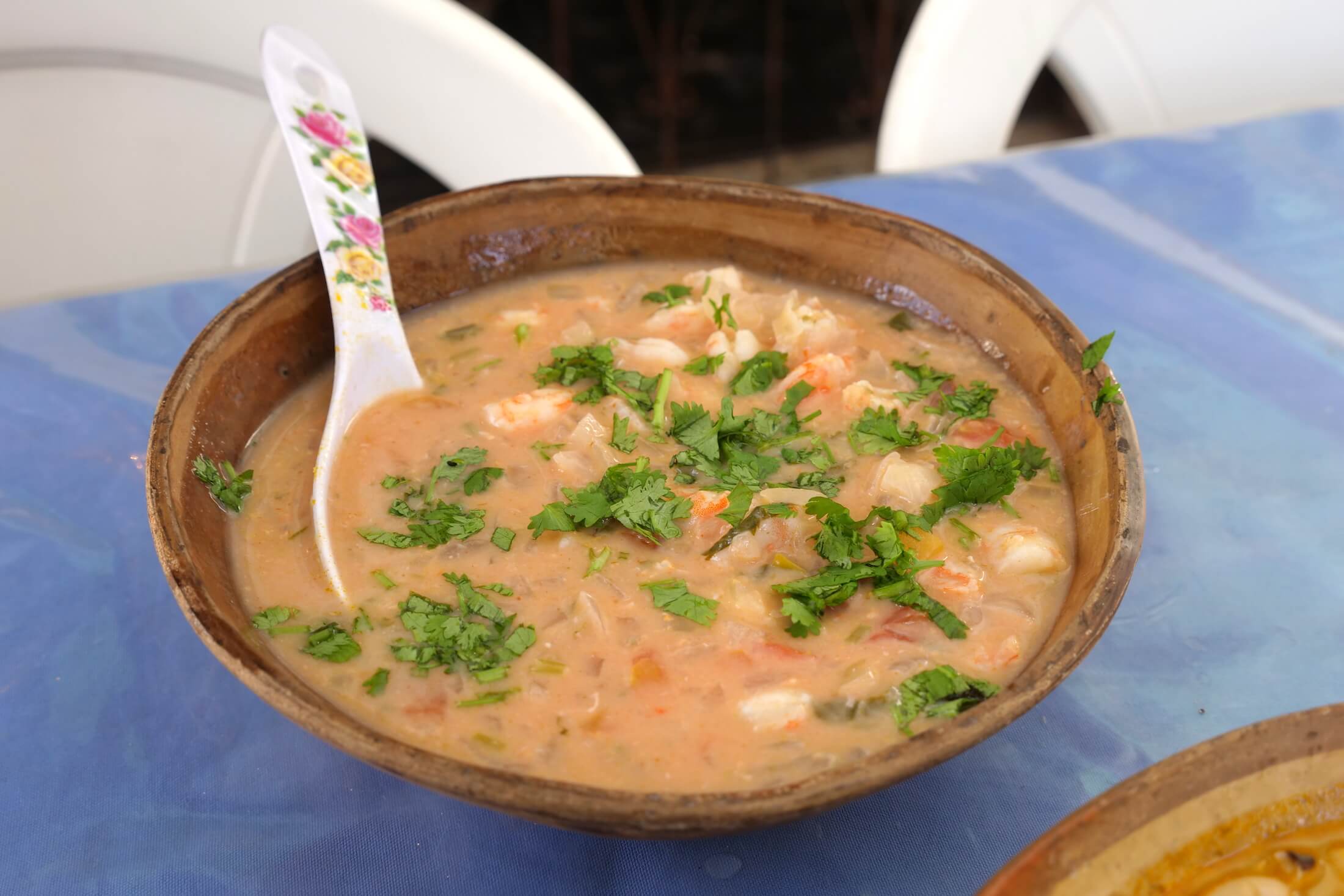
3. Bahian Shrimp Stew (Ensopado de Camarão)
‘Ensopado‘ in English translates directly to ‘stew,’ and this shrimp stew is another delicious example of food here in Salvador.
Its mostly sour in flavor, but the consistency is so incredibly creamy. You can have it with plenty of different main ingredients, but at Dona Suzana’s this stew is full of lots of Brazilian seafood.
How To Make Ensopado de Camarão
Starting off with the stew broth, the recipe I had that tasted best was one that was very thick with coconut milk (the chef, Dona Suzana, also uses a lot of both tomatoes, and okra in her recipe, for even more thickness and rich texture).
There are also chunks of onions, carrots, and green pepper, finishing with fresh cilantro on top just before serving.
I love the bright taste of that sour stew with a few shrimp, and all the soft onions. I don’t know if the local recipes prefer lime juice or vinegar, but its wonderfully sour as well as being so rich (and this is such a great combo to have with moqueca, by the way).
Another Bahia favorite is ‘bobo,’ and you could also try to eat this food at the nearby Mercado Modelo (Salvador’s Central Market).
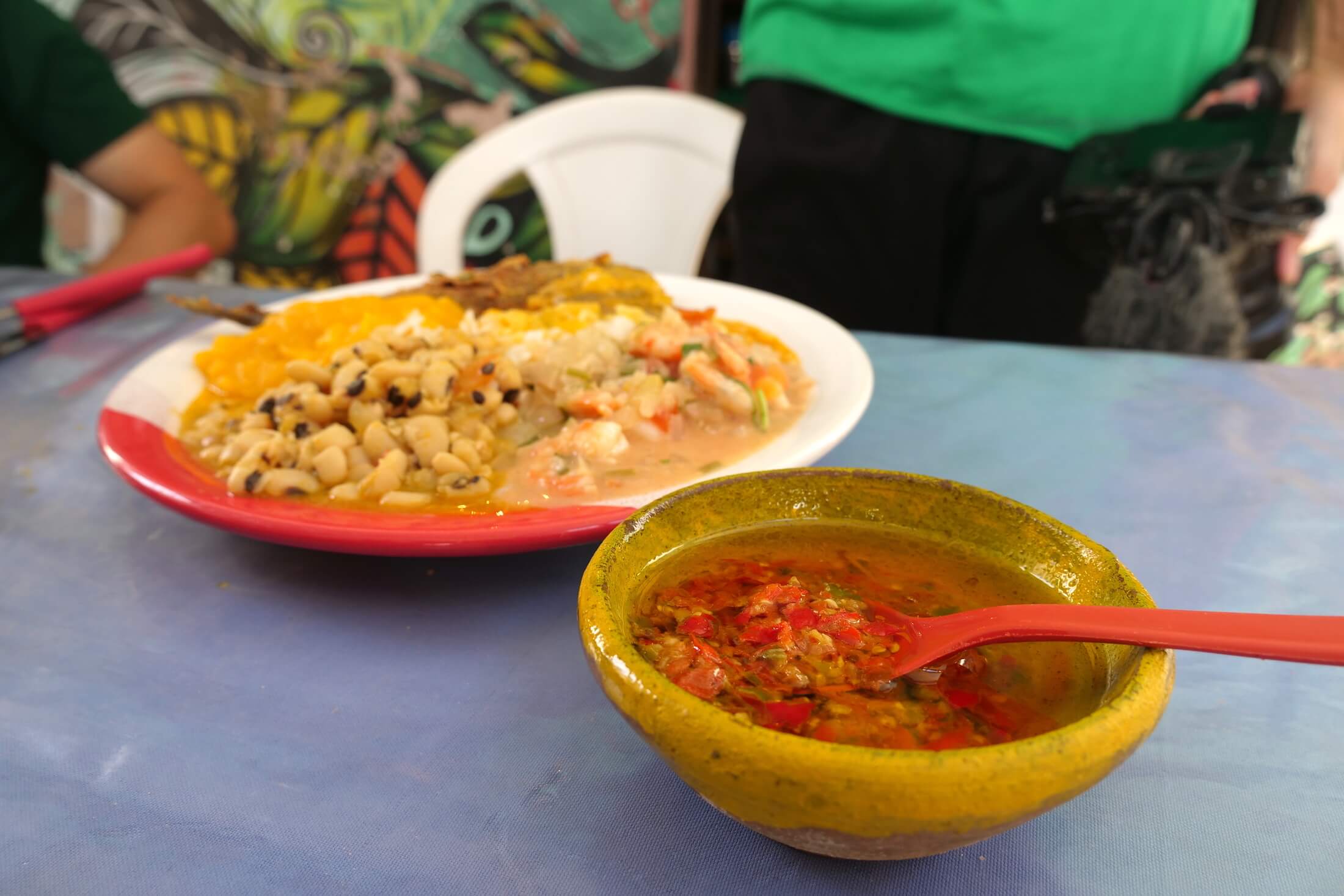
Where Do Brazilians Eat Shrimp Stew?
One of the most stunning locations so far out of all the meals we had in Brazil, Ré Restaurante Doña Suzana has an absolutely perfect place for your late lunch meal today.
So good, I wrote an entire article about it here (link).
Name: Ré Restaurante Dona Suzana
Location: Google Maps (link here)
Hours: Open Daily, 12pm to 6pm
Price: R$87 for our entire meal for 4 (US$22.41)
How to Eat Ensopado
As you are so near the seashore here, why not go a little crazy for Brazilian seafood. Ensopado is a great way to start, but you should order at least one of each of the popular dishes to go with it.
Try one dish each of shrimp, ocean fish, and manta ray, a great combo of Salvador’s three favorite seafoods. I think this ensopado stew tastes best with shrimp, but of course feel free to find your own favorite combination.
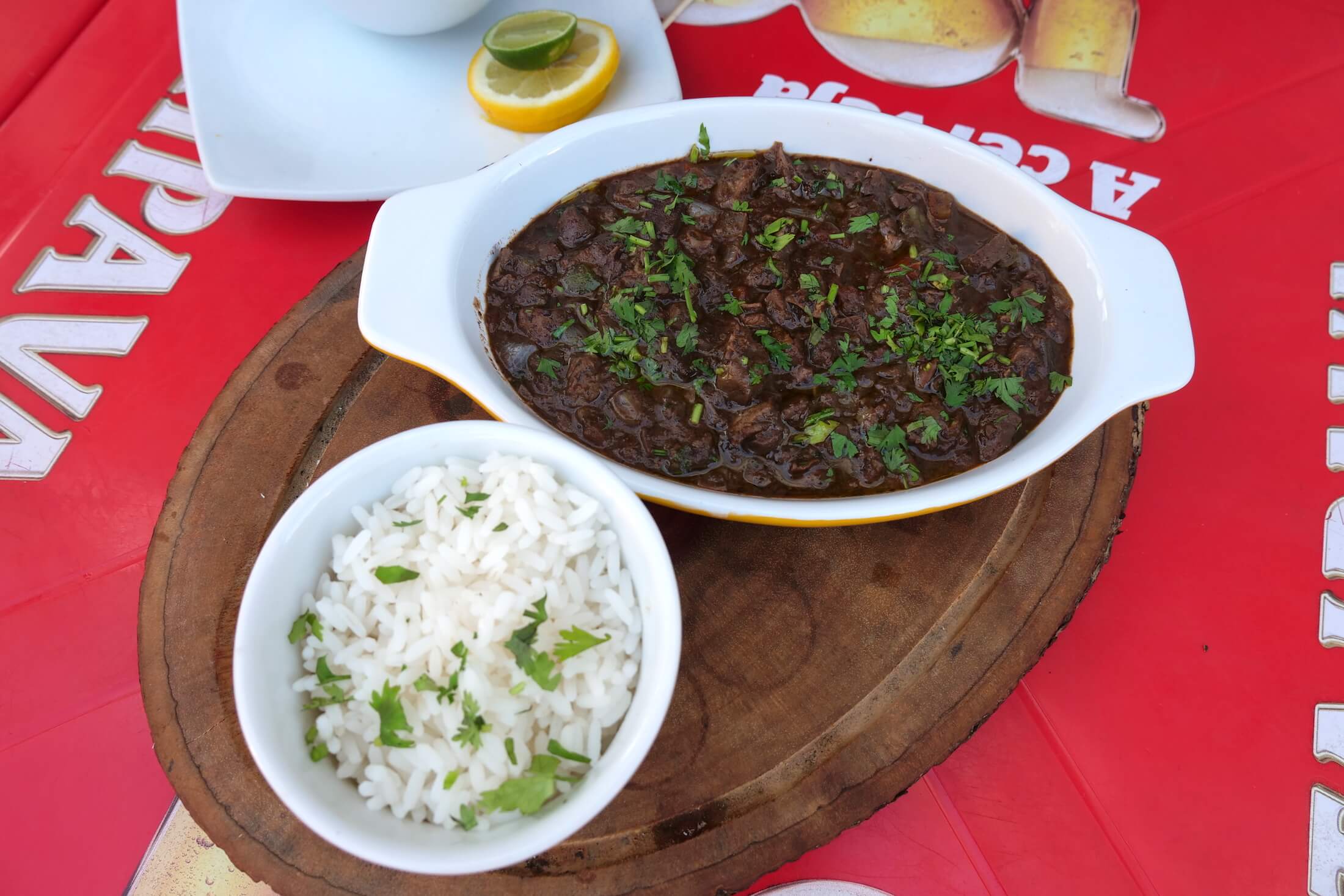
4. Meat and Innards Stew (Sarapatel)
Including just a few vegetables, and a wonderful mix of meaty ingredients, Sarapatel is an amazing local food in Salvador.
People usually eat this food with rice, in the afternoons or evenings. It can be a great food to have in the afternoon, as Sarapatel tastes so great with a nice, cold Brazilian lager beer.
Sarapatel is one of the dishes where you can see very obvious Portuguese influence on the local cuisine of Brazil. Even though its so meaty, it doesn’t necessarily need to be ‘dinner’ on its own (many people will go out for larger meals later in the evening).
Order this with a side of white rice, and squeeze on some juice from a lemon or a lime.
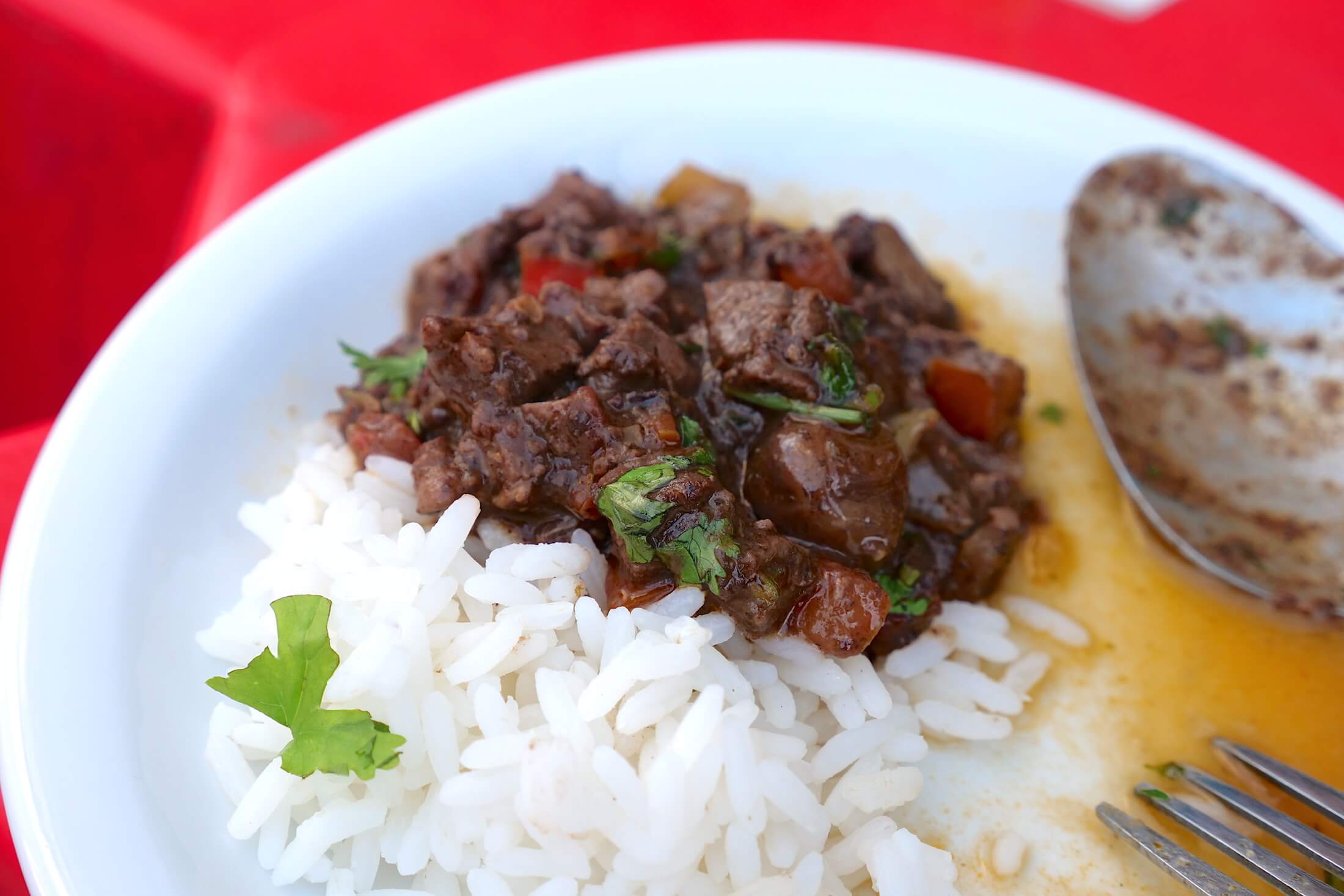
Where To Eat Sarapatel in Salvador?
I think its a great food to have just before dinner, and we had a great version of this food at a local restaurant Boteca di Janela, in Salvador.
She makes it extra rich by including large portions of blood while cooking the soupy liquid, as well as thick chunks of skin and chewy intestines.
(By the way, locals know Boteca di Janela for its great appetizers, and extremely cold beer)*
Name: Boteca di Janela
Location: Google Maps (link here)
Hours: Open 11am-4pm Thurs. and Fri., and 12pm-6pm on Sat. and Sun. Closed Mon. to Wed.
Price: R$87 for our entire meal for 4 (US$22.41)
*Back Story – This restaurant just has a very cool small-neighborhood Salvador vibe – if you’re lucky, there might be a local football match happening in the afternoon. The stadium is just around the corner, and you can hear the live cheering, as well as watch it on local TV. Look over the shoulders of excited fans while getting deep into your own afternoon snacks of Salvador’s best local food.
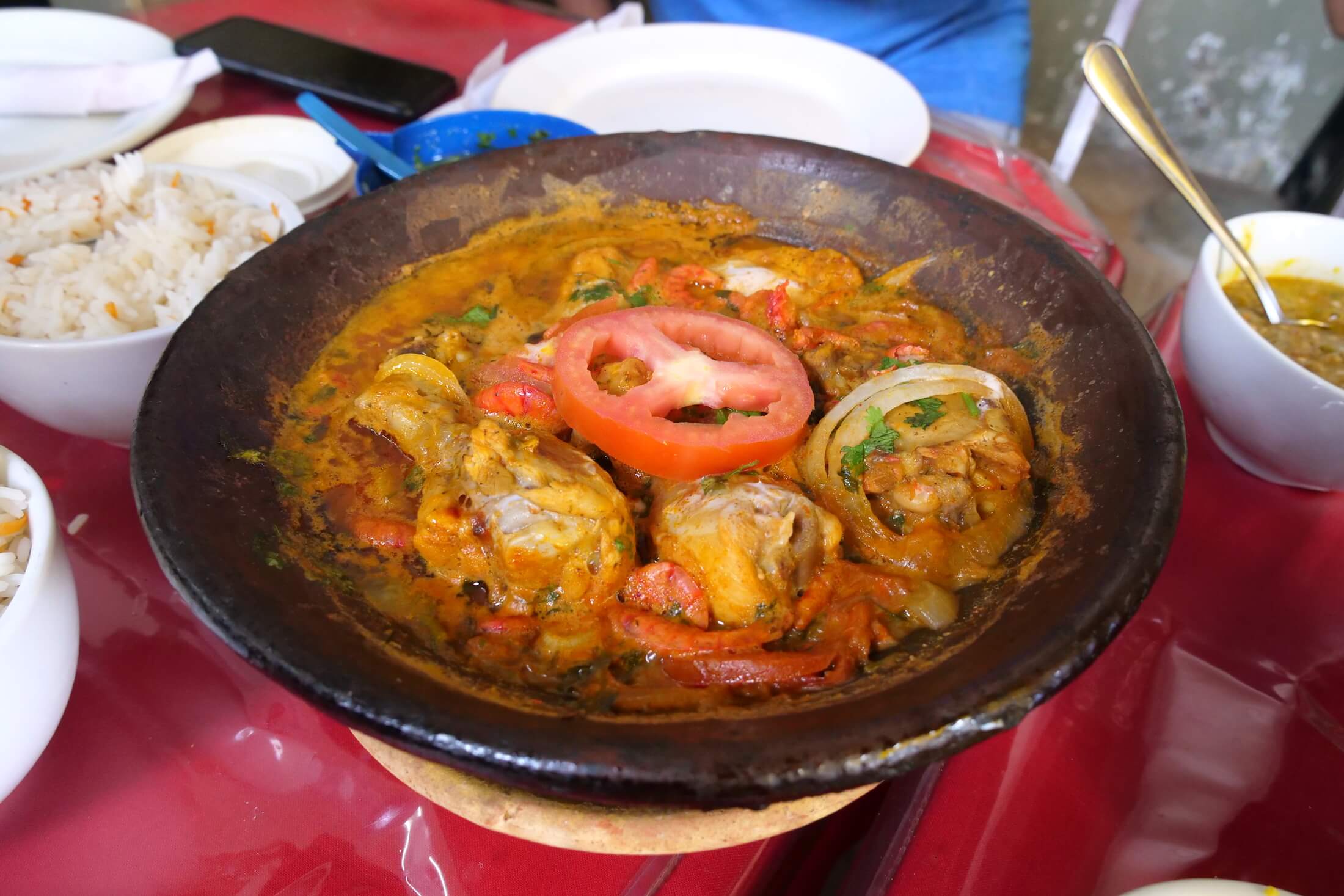
5. Chicken XinXim (Xinxim de Gallina)
One of the most amazing looking foods in all of North Eastern Brazilian is Xinxim de Gallina.
This food is full of dry spices, peanuts and a mash of cashews, and a small amount of green vegetables for flavor while it stews. I can only think of a curry when the massive plate first arrives at the table, but this is not a curry (as there is no curry paste).
Xinxim de Gallina is incredibly creamy, and rich, as the recipe includes palm oil at the beginning. It then gets a second healthy portion of coconut milk, just before it comes to the table.
Gallina is chicken meat, and usually gallina will be an older chicken, with flavor more suited towards soups or stews (like the one you see in the photo above).
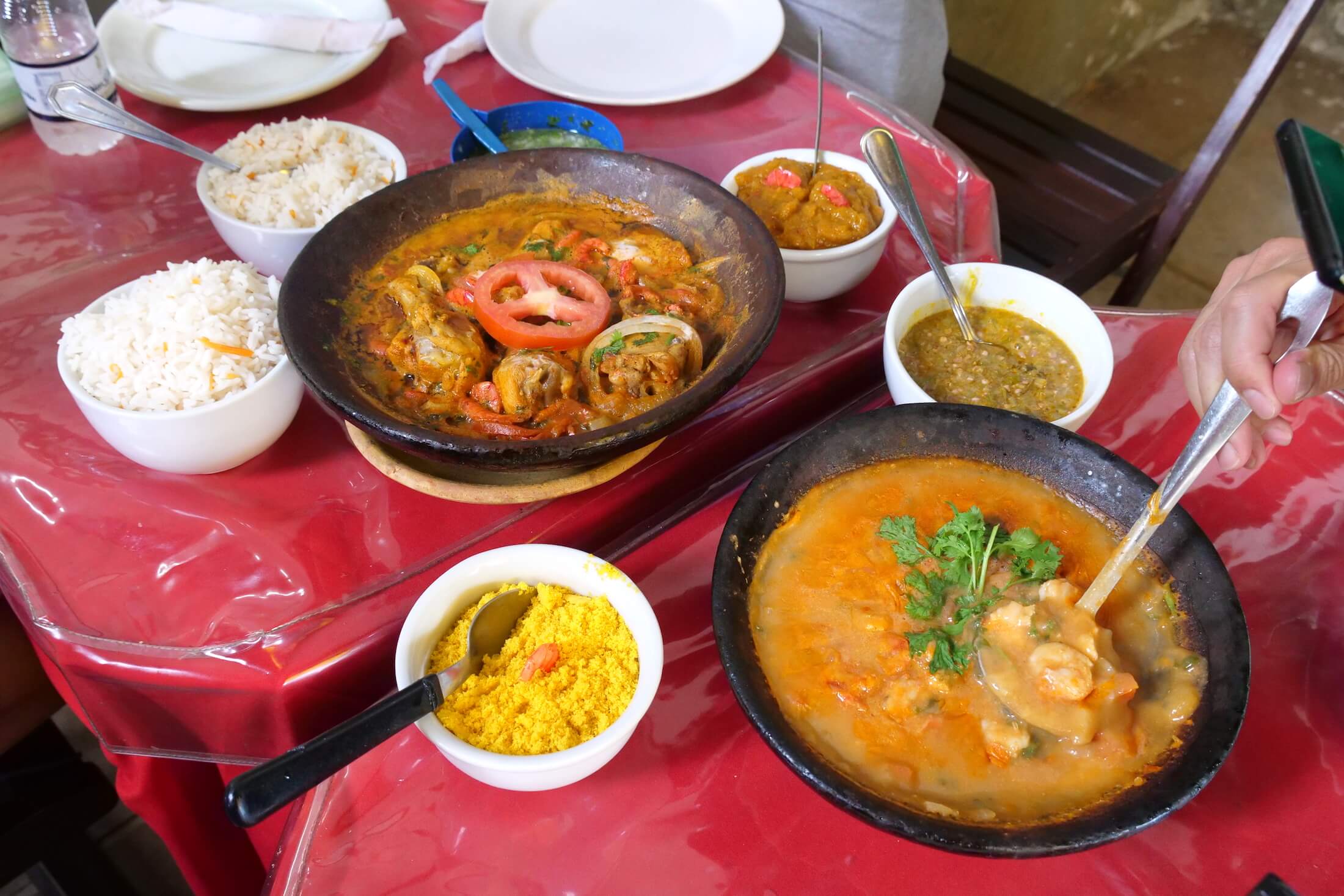
Where Do Locals Eat Xinxim de Gallina?
Name: Jacy Restaurant
Location: Google Maps (link here)
Hours: Open Daily 7am to 4pm, Closed on Sunday
Price: R$180 for everything, plus another full Xinxim for take-away
How to Eat This Food
Many people order Xinxim de Gallina as a main dish to share, and during our meal in the Mercado Modelo market we had it like this as well.
Along with an order of ensopada de camarao (Bahian Shrimp Stew, #3 in this Salvador Food List), you might have some delicious pirãu here (a smooth mash of cassava and dendê oil), and a large bowl of caruru (okra paste with a mash of peanuts and cashews).
Note: This market is full of tourists, but if you want a great spot for real and authentic local food of Salvador, then start at the North side of the market. Find the hallway where Jacy is doing the actual cooking (link above), and take a seat at one of the tables immediately beside her stall.
Get exclusive updates
Enter your email and I'll send you the best travel food content.
